The DALLAS JANUARY 13-14 PUBLIC SPEAKING CLASS IS ALMOST FULL! RESERVE YOUR SPOT NOW

- Public Speaking Classes
- Corporate Presentation Training
- Online Public Speaking Course
- Northeast Region
- Midwest Region
- Southeast Region
- Central Region
- Western Region
- Presentation Skills
- 101 Public Speaking Tips
- Fear of Public Speaking

How to Create the Perfect Presentation Handout

One of the most often overlooked parts of a presentation is the presentation handouts. So, in this post, we’ll give you a few examples of presentation handouts that you can create very easily and add impact to your speech or business meetings.
Good speakers and lecturers usually give presentation handouts to accompany their speeches. As a result, a great presentation handout can make your speech more memorable. It gives your audience the freedom to listen to your presentation instead of frantically taking notes.
The handouts you provide also help them remember the key points and highlights from your presentation, making your talk even more valuable. People are grateful for a good handout and will remember you (and the main points of your speech) long after the talk ended. Finally, your handout can be used as an exceptional marketing piece. If it is good enough, your audience members will both keep it and share it with others.
Want to beat stage fright, articulate with poise, and land your dream job? Take the 2-minute public speaking assessment and get the Fearless Presenter’s Playbook for FREE!
The Successful Speaker’s Guide to the How to Create the Perfect Presentation Handout.
The first rule of slide club is never handout your slides to slide club..
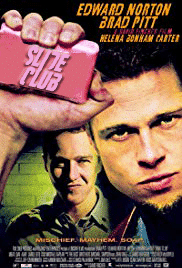
This has always been a hard and fast rule in my business presentation classes. But I have to admit, in recent years, I’ve changed my tune slightly here. When I first started teaching presentation classes, PowerPoint was still in its infancy. And the slideshows that people were creating were really awful. Folks would just create a never-ending series of bullet points on a never-ending slide deck. Since most presentations covered way too much content, it was impossible for the audience to retain most of it. In order to prevent information overload, presenters started printing off their slides and distributing the printed slide deck to their audience as a handout. As a result, the presenter ends up with a bad presentation accompanied by a bad handout.
However, if you get creative with your slides, you can actually use a printout of your slide deck to make your presentation more interactive (more on this later). The main point here is if you have a ton of content in your presentation, stuffing that content onto your slides and then just printing out your slides is not a good idea.
I sometimes make this point in class by starting to deliver a data-heavy slide deck. It typically only takes a few slides before someone in class figures out that I’m violating almost every tip that I’m giving them.
At that point, there is usually a nice laugh. I then switch to a better slideshow that is more audience-centered. The funny thing is, though, that before the class figures out that the bad PowerPoint presentation is a joke, someone in the class will often ask me if I will send them the slide deck. So, if your audience is asking you for your slide deck, your presentation is probably not designed very well .
Three Easy Examples of Handouts for Presentations.
Presentation handout example #1: just use slide notes in powerpoint as a presentation handout..
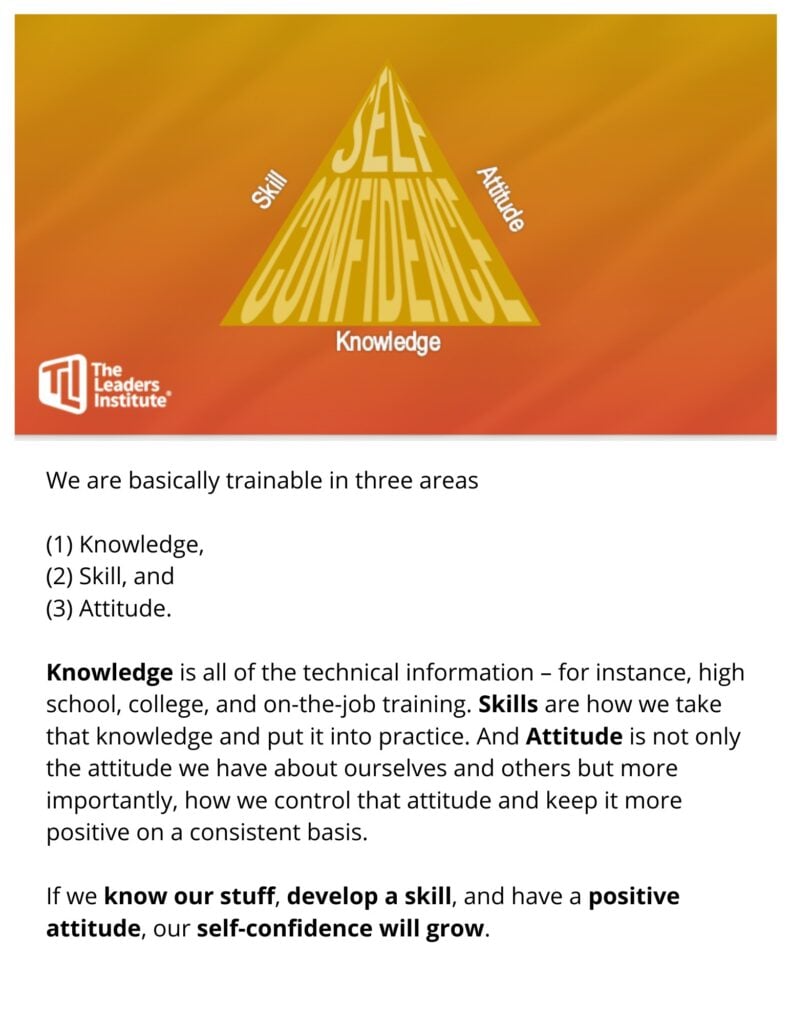
One of the main reasons that I have always encouraged my class members to not print out their slides is that the slides, without the speaker, aren’t going to make a lot of sense. However, most people will jot a few speaker notes of important information they want to say in the presentation. If you use the techniques that I cover here, you’ll likely create an outline with a few key items. You’ll likely also use stories, examples, analogies, anecdotes, quotes, statistics, and the like. Well, if you already have that content created before you create your slide deck, you could just insert that content into the Slide Notes in PowerPoint. Viola! Instant presentation handouts.
The Second Example of a Presentation Handout: Give Main Concepts with Space for Audience to Add Notes.
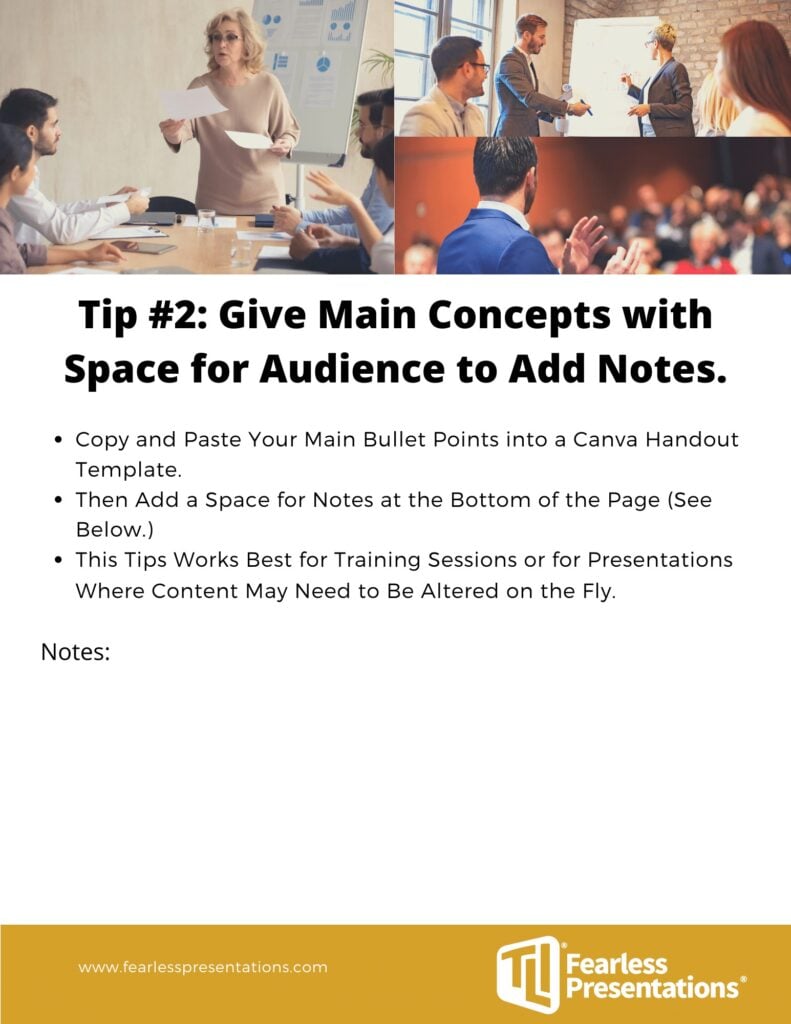
A friend of mine leads three-day training boot camps where he teaches social media marketing and website development. His handout is a three-ring binder full of printed pages. Each page has a series of rules followed by a quarter page of blank space. I once asked him, since the content that he was delivering was so detailed, why didn’t he just type it up and include it in his manuals.
He laughed and told me that he used to do that very thing. But the content in his industry was changing so quickly that, the moment he printed a new manual, those additional details would already be outdated. So, now, he just prints the core message. Then, he allows his students to fill in the blanks with the most current content that he delivers from the stage. (He gets fantastic reviews, by the way.)
I love this technique. It keeps the audience involved. It also allows the audience members to write out the content that is most important to each of them at the time they attended the meeting.
The Most Effective Example: Create a Presentation Handout that Contains Extra Content Not in Your Presentation
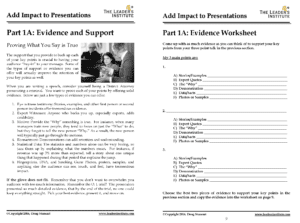
You want to include the content from your presentation in a written format. But you also want to add additional information that you won’t cover in the presentation. This is the technique that we use in our seminars and workshops.
For instance, if you are going to use a story as a piece of evidence in your verbal presentation, use a different story in your handout. If you use an analogy in your presentation, use a quote in your handout. When you use audience participation in your presentation, use a unique photograph in your handout.
If you do this, your target audience will see you as a valued expert on the topic. By the way, it is okay to use some of the same content in your slideshows, your oral presentations, and your handouts. It is important to be consistent. However, you want your verbal presentation to cover some key ideas that aren’t in your handout. And you want your handout to cover detailed information that you don’t speak about.
This type of presentation is a great handout because it becomes a textbook for your presentation. It does take longer to create a well-prepared handout. But you will find that the value to your audience far outweighs the additional effort.
During the presentation, you’ll want to say something like, “I’ve given you additional examples in your handout,” or “If you want the full step-by-step approach, you can download the handout from my website at [your URL].”
A Few Bonus Tips to Add Impact to Your Handouts.
Add a list of reference material for further reading
Your audience members will want to pick your brain. They want to know where you went to school, what kind of work experience you have, and most of all, where they can read more about your topic.
There’s a ton of resources out there, so instead of having your audience sort through them (or risk boring them with way too much detail in the presentation), just lead them in the right direction with your recommended reading. If the book is hard to find, or only available online, remember to include the link to where it can be purchased.
Consider adding a worksheet or action sheet
Depending on the type of presentation or speech you’re giving, you will likely have a call to action at the end, where you will encourage people to change or act on something related to your talk.
If a worksheet helped you implement these changes before, include it for your audience. Even a notes section located in the back of your handout will be an effective tool in case your audience wants to jot something down.What did your last handout look like? What will you change for next time? Let us know if you end up implementing any of these tips.
For additional help, here are a few additional posts:
- How Many PowerPoint Slides Should You Have for Your Presentation .
- Make Your Handout Look Great without a Graphic Designer .
- How to Design Your Presentation in a Few Simple Steps .
- We Use the Software Canva to Create Great Presentation Handouts with a Professional Layout
Download the Free How to Create a Great Presentation Handout… Handout.

Free Public Speaking Tips , Podcasts , presentation skills
View More Posts By Category: Free Public Speaking Tips | leadership tips | Online Courses | Past Fearless Presentations ® Classes | Podcasts | presentation skills | Uncategorized
Looking to end your stage fright once and for all?
This 5-day email course gives you everything you need to beat stage fright , deliver presentations people love , and land career and business opportunities… for free!
Home Blog Design How to Create the Perfect Handouts for a Presentation
How to Create the Perfect Handouts for a Presentation
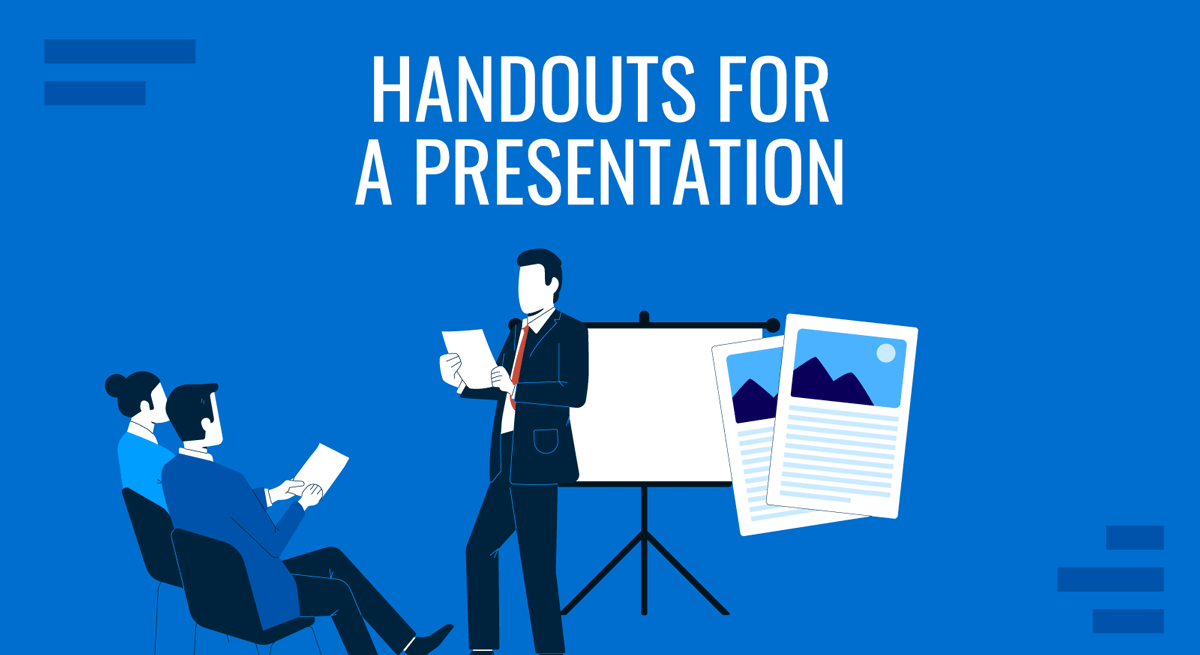
As we presenters know, aiming for a flawless presentation experience involves not only top-notch presentation skills but also graphics, a well-thought-out presentation structure, and articulating both how to start a presentation and how to conclude a presentation. Yet, very little is said about presentation handouts and their role in large-scale meetings, or their value when securing business deals.
Seasoned presenters acknowledge the impact of a presentation handout, and today we’ll guide you in the process of creating these printed-format assets to make your presentation more memorable.
Table of Contents
What is a Presentation Handout?
The role of presentation handouts, why create handouts for large scale presentations, examples of effective handouts for presentations, how to create presentation handouts in powerpoint, how to create presentation handouts in google slides, best practices for presentation handouts, final words.
A presentation handout is a supplementary document provided to the audience by the presenter or the event’s organization during or before a presentation. The core purpose is to enhance the understanding and retention rate of the information shared or to provide contact points with the presenter via email, LinkedIn, website, or social media profiles.
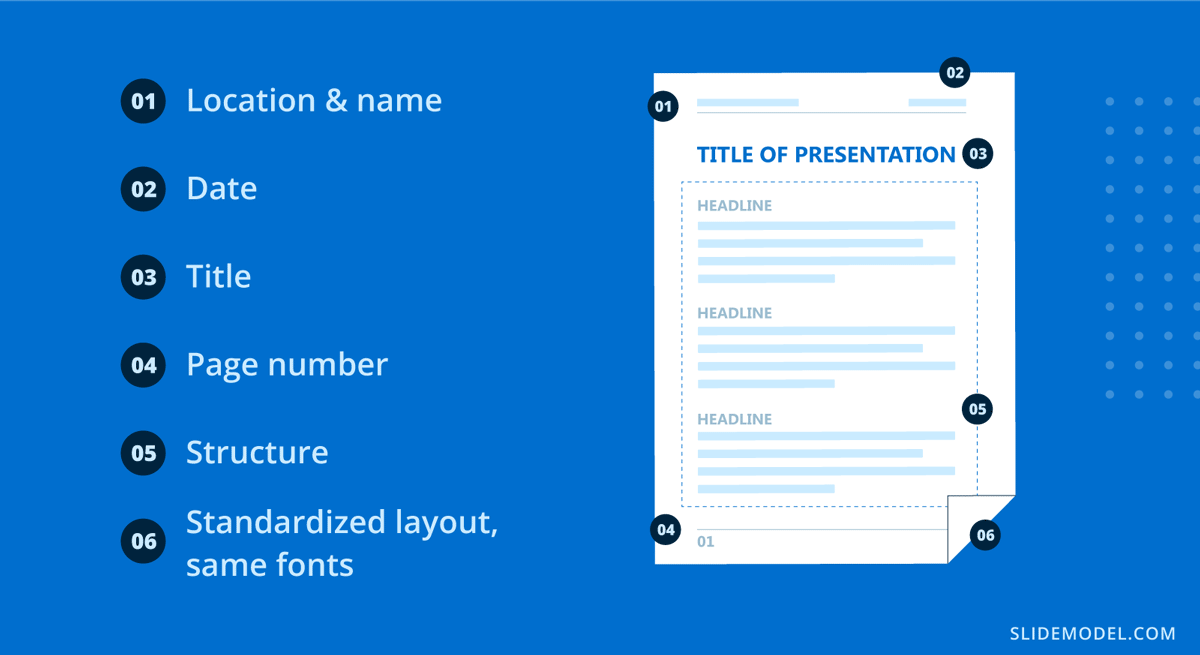
Handouts in presentations allow attendees to follow along more easily, take notes on specific parts, and have a further reference – ideal in large corporation events. The talk may not fully cover information, like detailed metrics, supplementary graphs, etc.; thus, they can be featured inside the handout to provide additional background on the presentation topic. In short, think of handouts as deliverable presentation aids .
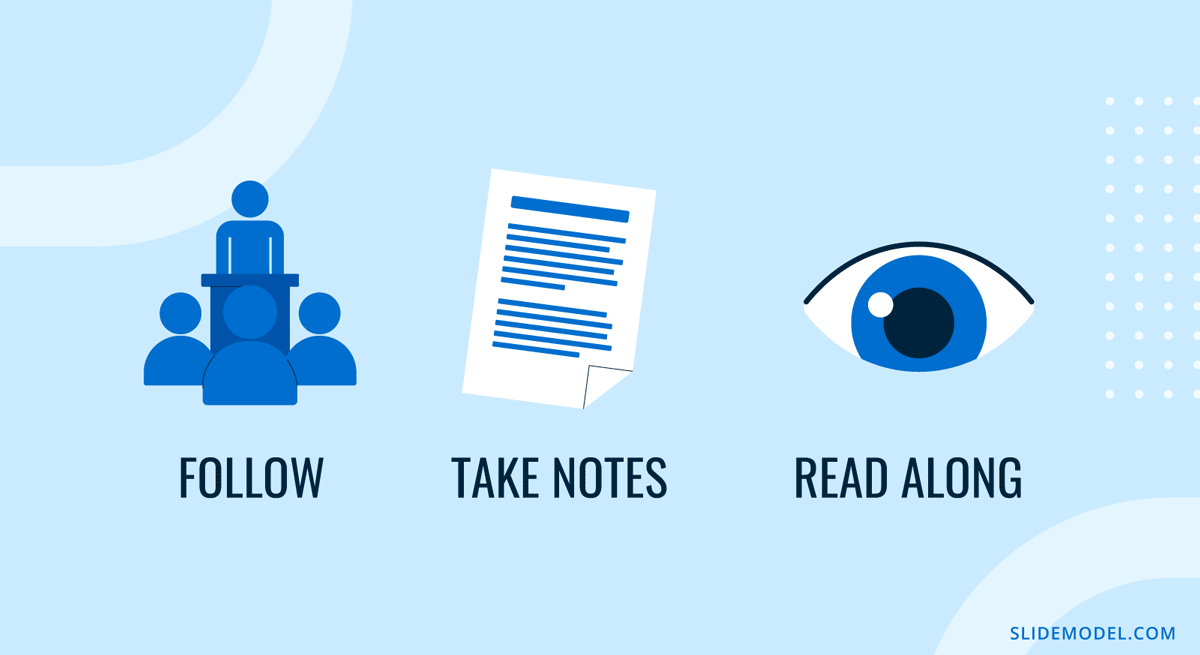
Picture yourself attending a series of presentations at a large-scale event, like a medical conference. How many research presentations can you retain in your head? 3-4 top, whereas perhaps you attended over 12 in the past 8 hours. Handouts for presentations simplify attendees’ efforts, as they have a palpable reference about the presentations they attended, who delivered the talk, the conference presentation slides , etc.
Another interesting point of view for handouts is when we position ourselves in the shoes of an attendee with a physical impairment, like lessened hearing capacity. In this situation, we can picture a handout example, as the presenter integrates the audience, even those who cannot fully participate, by delivering information in a physical format.
When covering examples of handouts for presentations, we can position ourselves in generalistic situations as follows.
Helping people with physical impairments
Handouts don’t necessarily have to be printed in text format. Braille handouts can be used to assist people with low visual acuity to understand the missing gaps between the speech and the visuals shown in the slides. Electronic devices with screen readers can assist, as well as an audible format of the handout.
For people with hearing impairments, printed handouts summarizing the presentation’s key points are valid, but another creative method is to insert a QR code in PowerPoint and link to a PDF document with the transcript of the presentation, plus the slides.
Illustrations and Diagrams
Think about hard-to-understand topics involving a series of charts or graphs to comprehend the disclosed information. Those same graphics can be given to the audience in the format of handouts, with callouts or visual aids that remind the attendees of the importance of those concepts.
Summarize Key Information
Suppose you attended a chef conference, where new technologies, methodologies, or recipes are shared in presentations. You can refer to the handouts for detailed instructions and focus on the training presentation in real time rather than taking notes.
Contact Data
Finally, we can consider a handout format for people who want to get in touch for business partnerships, academic collaborations, etc. Rather than delivering a business card, provide additional information about your work and deliver a handout.
Follow these steps to create handouts in PowerPoint.
Open your presentation in PowerPoint. Go to the View tab and find Handout Master .
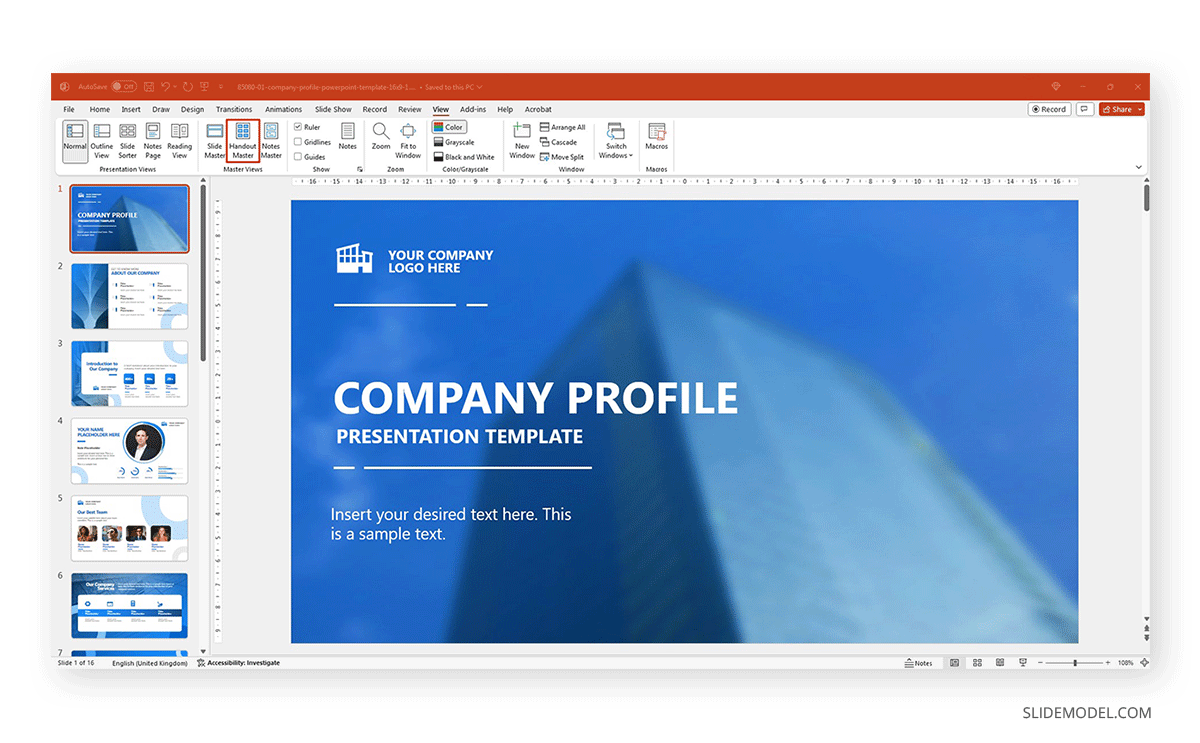
You can customize the appearance of your handout by adding a header, date, logo, contact details, etc. This works exactly the same as Slide Master in PowerPoint , so all changes will be reflected on all pages in your handout.
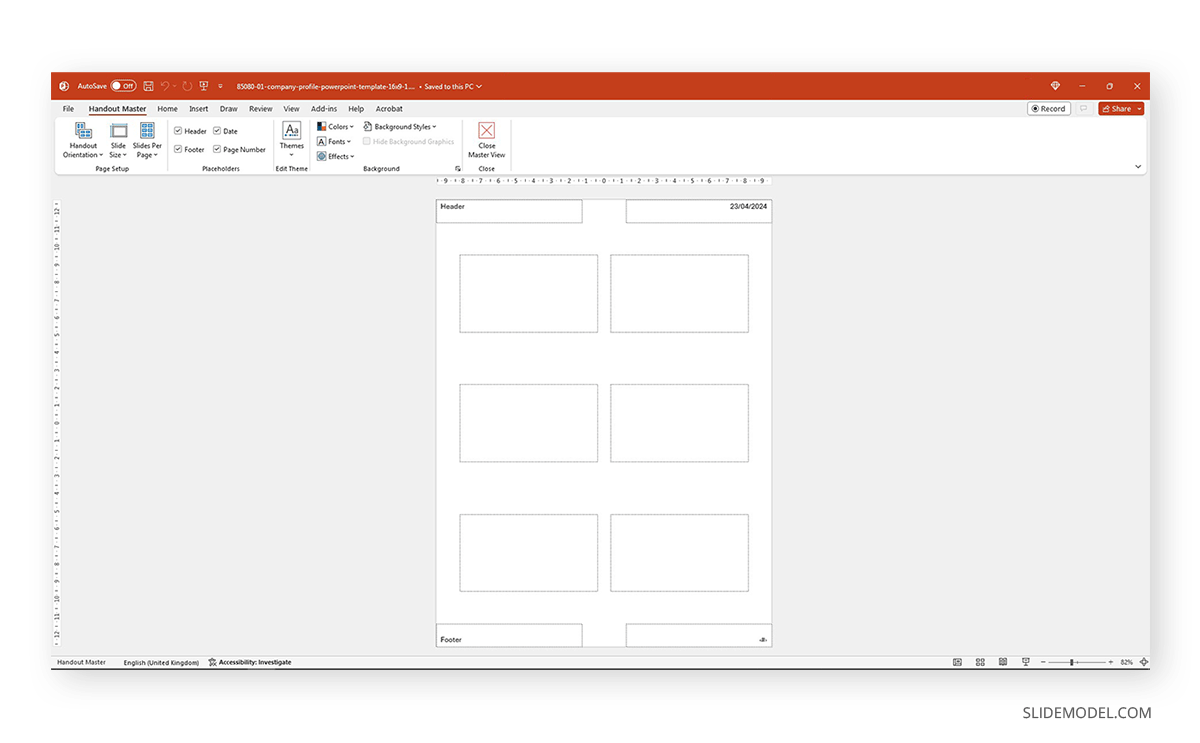
Now, go to File > Export and select Create Handouts .
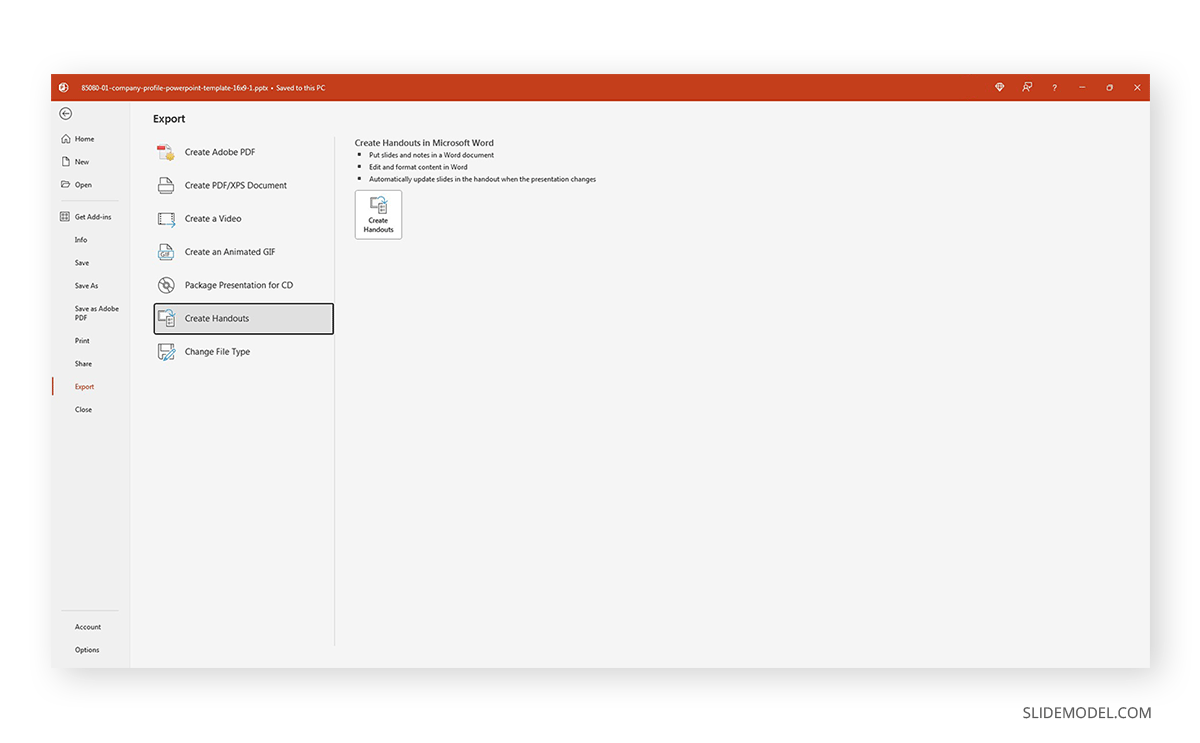
Click on the Create Handouts button, and you will be prompted with a context menu with the following options:
- Notes next to slides
- Blank lines next to slides
- Notes below slides
- Blank lines below slides
- Outline only
Select the option you prefer. We highly recommend selecting Paste to add a tiny version of the slides to your new handouts document.
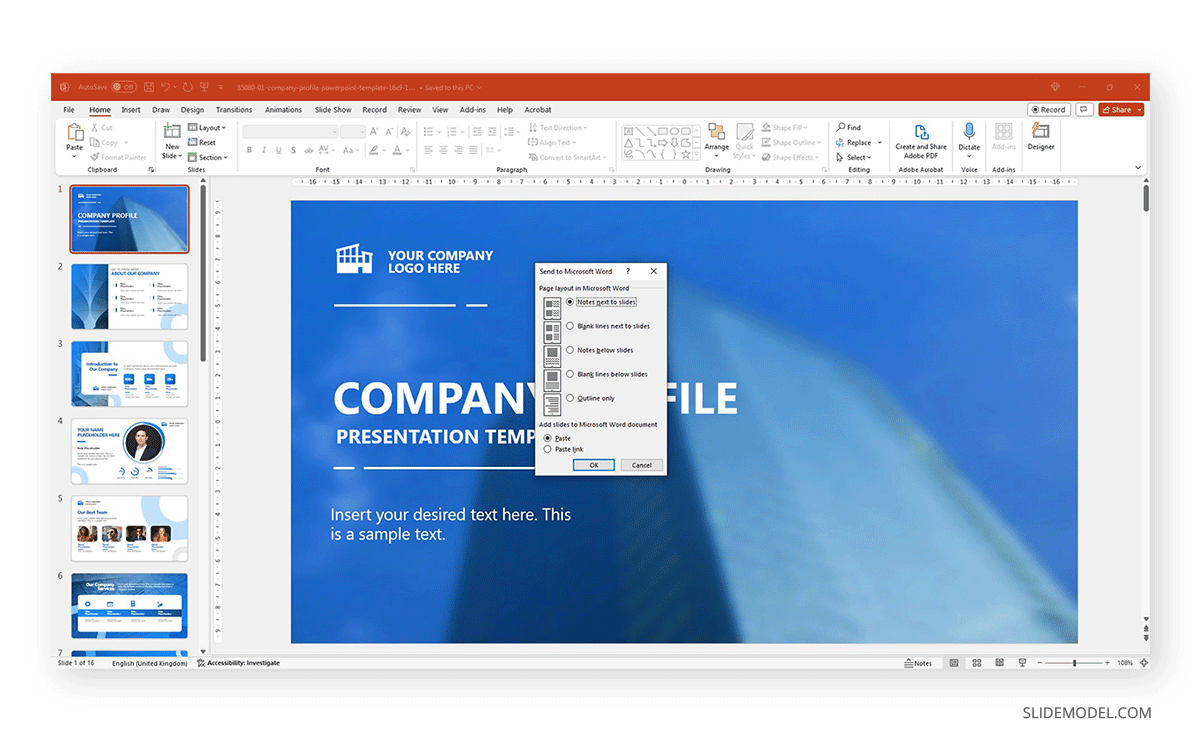
Once that’s done, a new Microsoft Word document will open with your presentation handouts, which can also be customized from Word.
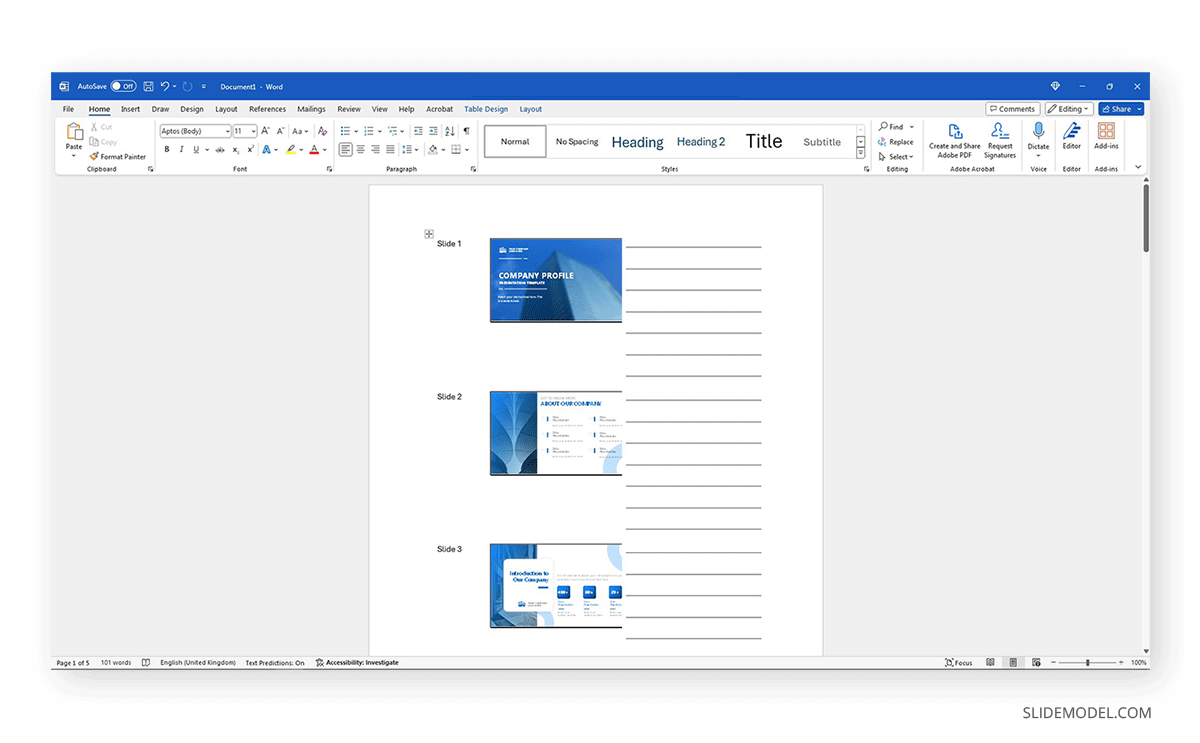
For Google Slides, the instructions are much simpler. Select your desired presentation in Google Slides and go to File > Print Preview . All options for how to print slides in Google Slides are now available.
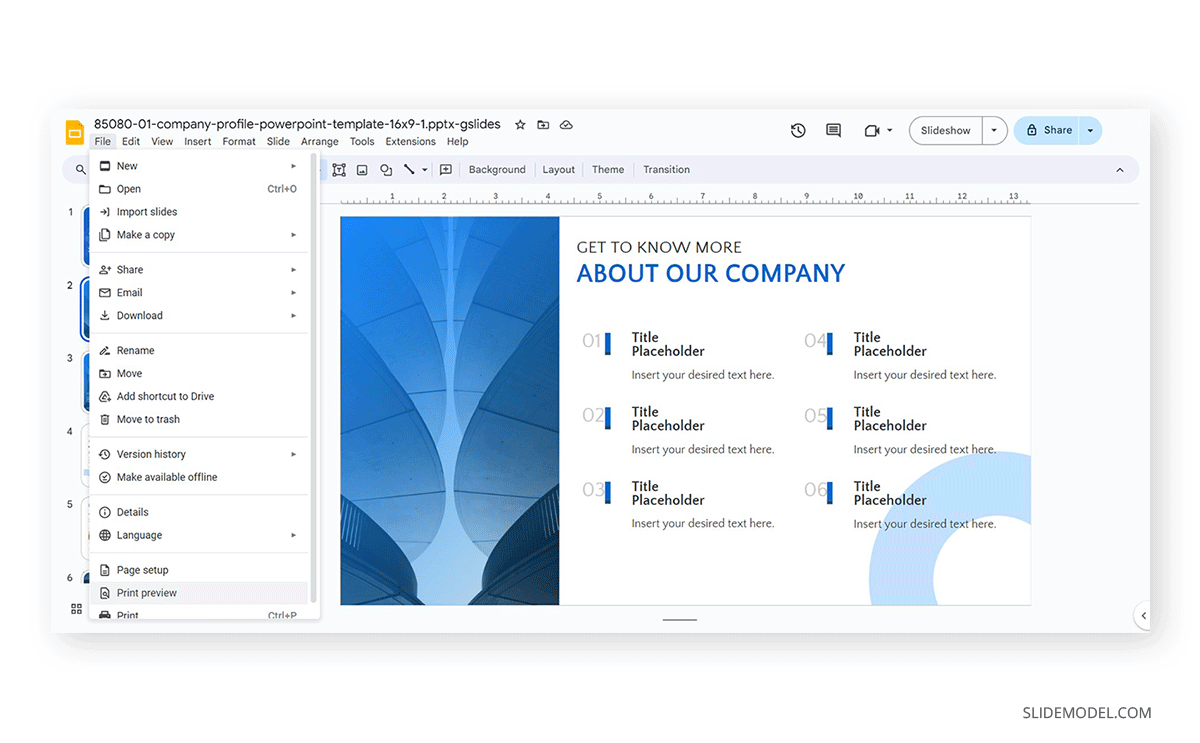
The option we’re interested in is the menu below the top bar that says 1 slide without notes .
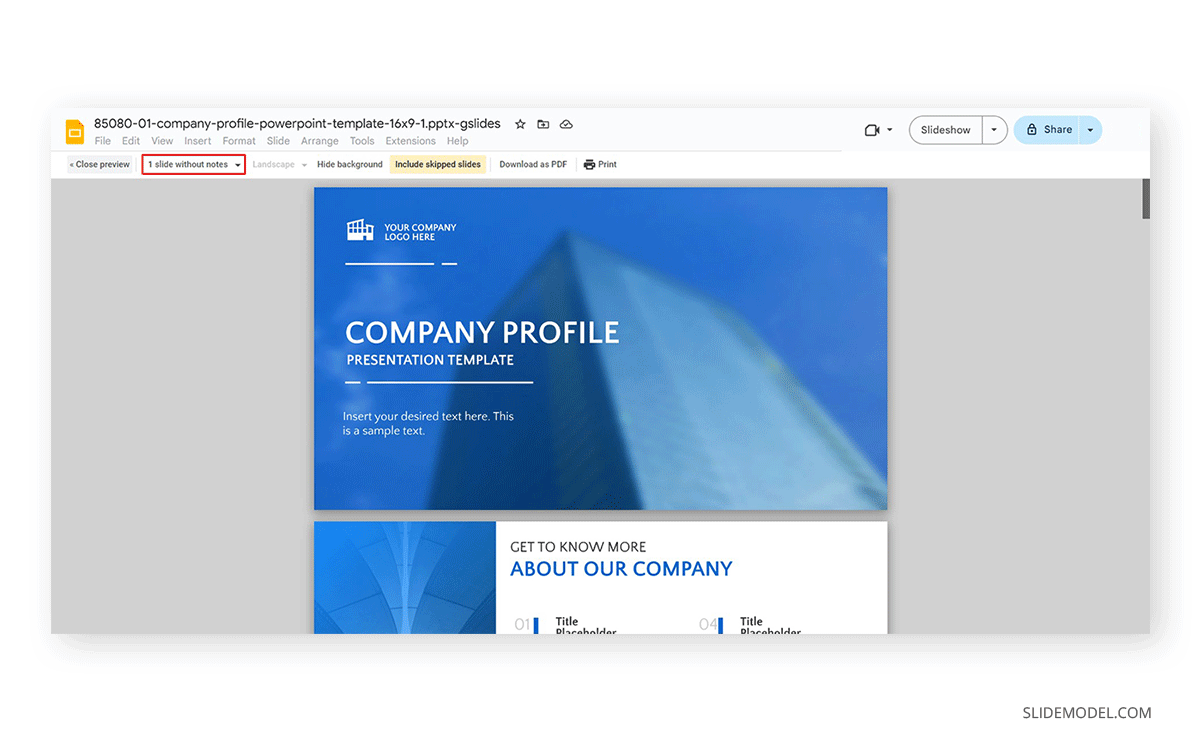
Open that and select Handout , with the number of slides per page you prefer.
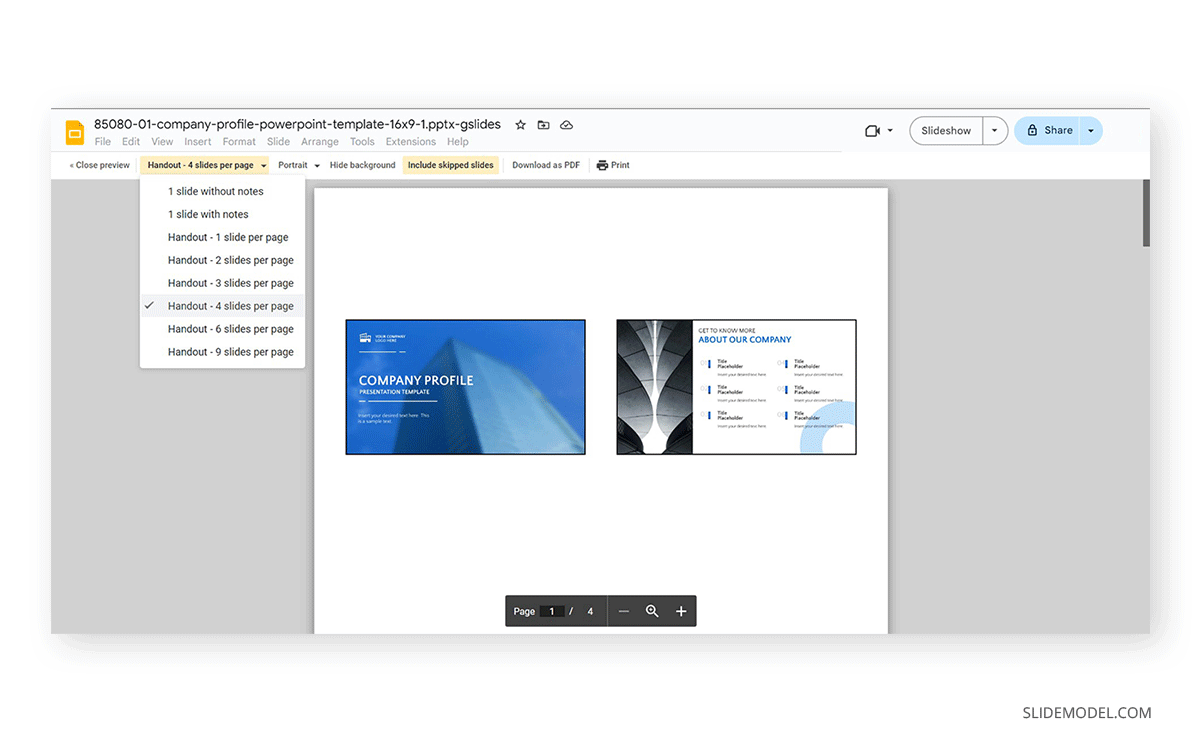
Then click on Print, and a new PDF document will be generated. Unlike PowerPoint, you have to edit everything beforehand or opt for a PDF editor like Adobe Acrobat.
Handouts should be concise. The idea is to summarize information, not to confuse the audience with an overwhelming amount of data. Although these recommendations are valid for all handouts created with PowerPoint templates and Google Slides, the same rules apply to handouts created in Graphic Design Software (Adobe Illustrator, Corel Draw, etc.), as it’s tempting to keep adding unnecessary data or complex illustration effects.
Sharing your handout before the presentation starts is advisable, as it’s the moment most attendees will gather and where the expectation about what the talk will be about is at its highest. In our experience, the audience tends to grow restless toward the last 5 minutes of your presentation, with some attendees leaving if they have to attend another conference with a very limited timeframe between both. Distributing a handout during the presentation is distracting and will negatively impact your presentation’s performance.
Finally, as you would do with poster presentations , focus on readability. Avoid using heavily contrasting colors or text that looks too small to read for the sake of adding more data. The handout is a tool to complement your presentation, not to summarize countless words.
Handouts for presentations are not an optional add-in. They are a vital element of effective academic and business presentations. By providing a clear structure to your handout or using digital mediums to help people with impairments, you are taking into account accessibility, one of the best practices you can engage early on in your path to becoming a professional presenter.
Like this article? Please share
Presentation Ideas, Presentation Tips Filed under Design
Related Articles
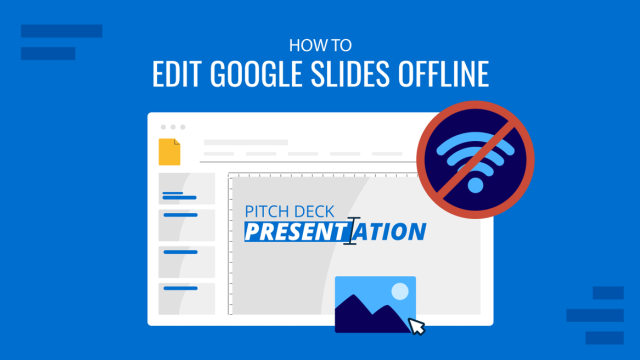
Filed under Google Slides Tutorials • December 24th, 2024
How to Edit Google Slides Offline
Don’t worry about the internet connection any longer. Learn how to edit Google Slides offline mode with this guide.
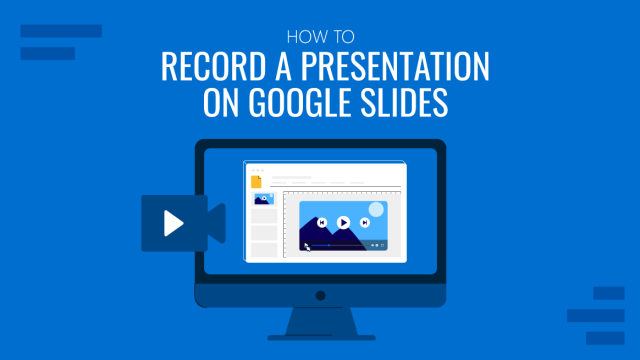
Filed under Google Slides Tutorials • December 10th, 2024
How to Record a Presentation on Google Slides
Create powerful educational content by learning how to record a presentation on Google Slides. Ideal for webinars, lessons and more.

Filed under Presentation Ideas • November 19th, 2024
What is the Best Way to Deliver Presentations with Authenticity
Do you feel as if your presentations look dull or robotic? Discover how to bring authenticity to your slides and speech with this guide.
Leave a Reply

Microsoft 365 Life Hacks > Presentations > How to create effective presentation handouts
How to create effective presentation handouts
Whether you create presentations for school, work, or clubs, distributing handouts makes an impression and amplifies your message. The benefits are twofold: putting together a handout prepares you for your speech and allows your audience to retain the information better.
You can put together handouts easily. Learn what to include to ace your next presentation.

Why are presentation handouts important?
Creating handouts help you prepare what you want to say . They also set expectations for your audience members and allow them to focus more on your speech because they don’t have to take such thorough notes.

Tell your story with captivating presentations
Powerpoint empowers you to develop well-designed content across all your devices
If you want to create an effective presentation handout, here’s what you should include.
1. List the key points of your presentation
To create a strong presentation handout, list the key facts from your speech. Keep it simple—you don’t need to rewrite your entire presentation. Remember, you’ll discuss a lot of the material in your slides as well. Listing out your presentation’s key points help your listeners reflect on the information later. By reading your presentation’s key points, your audience may also come up with or remember the questions they want to ask you at the end of your talk.
2. Include your sources
Effective presenters back up their information with sources, especially in science and history-related fields. Providing sources encourages your audience do more research on their own time. You can also provide further reading in your handout, like books or article links, if you aren’t able to cover everything in a single lecture.
3. Make your presentation handout professional
A professional-looking presentation handout establishes your credibility and authority with your audience. When presenting for work or an organization, include your logo on your handout.
You don’t have to be a graphic designer to create an attractive presentation handout—explore dozens of free Microsoft Word templates you can use to polish your handout.
4. Include white space
Not everyone comes prepared for a presentation. Leave white space in your handout so your audience can take notes on what you say. They can also use this space to write down questions they want to ask you, so they don’t forget them by the end of the presentation.
5. Include your contact information
Audience members may want to ask you questions about your presentation later. Include information like your name, job title, website, and email so your audience can contact you in the future.
6. Proofread your handout
Before you print out or email your presentation handouts, make sure to thoroughly proofread everything first. Are your sources spelled correctly? Are there any typos in your email address or links? Do the key points correspond with your presentation? Taking the time to review your handout before finalizing it will ensure it’s a quality handout.
Creating a presentation handout will make your presentation stronger and the information easier to digest. Are you feeling nervous about an upcoming presentation? Learn how to calm presentation anxiety .
Get started with Microsoft 365
It’s the Office you know, plus the tools to help you work better together, so you can get more done—anytime, anywhere.
Topics in this article
More articles like this one.

4 presentation trends for 2025
Learn which latest presentation trends can make or break your PowerPoint’s message and leave your audience captivated.

How to make your PowerPoint presentations accessible
Check out tips for using PowerPoint accessibility features, so your audience won’t miss any part of your presentation.

How to make your presentations more attractive
Explore tips on how to make your PowerPoint presentation design aesthetically pleasing, no matter the subject.

How to introduce yourself in a presentation
Gain your audience’s attention at the onset of a presentation. Craft an impressionable introduction to establish tone, presentation topic, and more.

Everything you need to achieve more in less time
Get powerful productivity and security apps with Microsoft 365

Explore Other Categories
Book a complimentary consultation
What type of service are you looking for, thanks we will contact you soon.
+1 (617) 982-3329
How To Create Effective Presentation Handouts: A Step-by-Step Guide [+ Examples]
Do you want to learn how to create handouts that capture and motivate your audience? Discover useful, detailed tips on handout content and layout that will make your presentation inspire and leave a lasting impact!

What’s a Rich Text element?
The rich text element allows you to create and format headings, paragraphs, blockquotes, images, and video all in one place instead of having to add and format them individually. Just double-click and easily create content.
- Nostrum non voluptas alias sit ut corporis perspiciatis nihil molestiae. Vitae quidem aut aut quia quia porro explicabo. Similique occaecati sit quo. Enim enim dolor ut. Et error alias nam fuga voluptas inventore placeat et. Eligendi similique officia provident magni aut quasi soluta qui.
- Deleniti totam eius similique repellendus.
- Deleniti totam eius similique repellendus. Doloremque sunt nihil et. Tenetur delectus velit ut. Pariatur velit ipsa.
3 Static and dynamic content editing
4 static and dynamic content editing.
A rich text element can be used with static or dynamic content. For static content, just drop it into any page and begin editing. For dynamic content, add a rich text field to any collection and then connect a rich text element to that field in the settings panel. Voila!
5 Static and dynamic content editing
6 static and dynamic content editing.
A rich text element can be used with static or dynamic content. For static content, just drop it into any pa ge and begin editing. For dynamic content, add a rich text field to any collection and then connect a rich text element to that field in the settings panel. Voila!
How to customize formatting for each rich text
Headings, paragraphs, blockquotes, figures, images, and figure captions can all be styled after a class is added to the rich text element using the "When inside of" nested selector system.
"Headings, paragraphs, blockquotes, figures, images, and figure captions can all be styled after a class is added to the rich text element using the "When inside of" nested selector system."

Presentation handouts can play a significant role in the process of effective presentation delivery if you know how to use them to your benefit. These supplementary means can back up your main message and make sure that your presentation creates a lasting impression.
Many people may think of handouts for a presentation as something they used to work on while in college. However, these additional materials — if they are well-thought-out and relevant — can assist business professionals, educators, and students equally well.
Today, we'd like to not only discuss the main purpose of presentation handouts but alsoshow you how to plan and design effective handout material. Moreover, we will share detailed tips and useful tools that will help you amplify the effect of your supplementary means.
Does that sound like a plan?
What Is a Presentation Handout?
Jerry Weissman, the author of Presenting to Win: The Art of Telling Your Story , compares the notion of a presentation handout to a bridge between your presentation and your audience’s long-term memory. We want to simplify this definition a little: Presentation handouts are additional materials that you share with the audience to support the central message of your presentation and aid comprehension.
Think of it this way: Presentations are a dynamic source of information, and a viewer does not have any control over its pace. A handout, on the other hand, remains a static source of additional information that the viewer can refer to at any time.
Usually, a presentation contains multiple vital aspects for the audience to focus on and digest. The main aim of creative handouts for presentations is to enhance viewer engagement and ensure a lasting impact once the presentation is over. You can refer to the handouts at any time during or after the presentation, so the materials improve retention and help to recall specific essential details.
The handouts mustn't replicate the presentation. They should complement it.
Planning Your Handouts

A great example of a presentation handout is a well-planned one. Never treat your handouts as a last-minute task. Here’s what to keep in mind as you begin the handout-planning process.
Key information
As you consider what data to include, start with additional statistics, relevant details, and supporting facts that strengthen the core message of your presentation. Choose information that helps the audience understand some field-specific or overly complex notions.
Tip: Highlight the main aspects that you want the audience to remember in your handouts.
Audience needs
Another critical part of handout planning is the audience you will interact with. Consider their level of expertise, needs, and preferences when working on supplementary materials. There will be little use of handouts that are irrelevant, overly simplified, or too complicated.
Format and structure
Even the best types of handouts for presentations will lose their impact if they are unappealing, illogical, or unorganized. A neat structure complemented by relevant visuals will enhance user perception and trigger their productivity. That is why you may want to play around with different headings, supporting images, graphs, bullet points, colors, and fonts.
Creating Effective Handouts for Presentations: Key Steps
A quality presentation handout template relies on effective design as much as it depends on the informative component. There are a few principles to stick to when you plan how to create a handout.
Step 1: Basic design
Whitepage pitch deck design agency outlines three principles that will assist you in creating a handout for your presentation:
Use these practical tips to move in the right direction:
- Present different types of content in complementary but distinguishable fonts.
- Section information with the help of headings and subheadings.
- Outline the main aspects through bullet points.
- Ensure that all the data is easy to read, avoiding small, unclear fonts.
- Use the same color palette and theme throughout the presentation and the supplementary materials.
- Add brand logos to stress consistency.

Step 2: Visuals
Compelling visuals make any information twice as easy to remember and digest. Whitepage professionals recommend the following:
- Use charts, tables, graphs, and other visuals to deliver complex notions concisely and more comprehensively.
- Intertwine text content with images that complement the core narrative.
- Symbols and icons aid in better understanding.

Step 3: Appeal and purpose
It is not enough to design visually appealing presentation handout templates. They should carry out an informative purpose as well. You can do the following to achieve the desired effect through your presentation handouts:
- Use different colors to highlight vital points and trigger the reader's interest.
- Use white space to define the structure of your handouts.
- Use contrast to attract user attention to critical aspects of the presentation.

Content Creation for Handouts
We may be stating the obvious, but your handout content should be clear and concise. You don't want to distract the audience from the presentation as they are trying to make out complex notions written in the supplementary materials.
A professional handout sample for presentation should:
- Deliver the main message without unnecessary details mentioned.
- Steer clear of tech-savvy language and slang and instead preserve an accessible tone.
- Present essential data through lists and bullet points.

On top of that, you can complement your handouts with appropriate relevant and appealing visuals. Different charts and images can improve information perception and enhance retention.
Lastly, presentation handouts prove to generate better results when spiced up with strategic, well-thought-out CTAs (calls to action):
- Give the audience clear instructions if any action is requested.
- Use questions and activities to promote engagement.
- Provide contact information in case someone decides to contact you later.
Utilizing Technology in Handout Creation

After you come up with your desired design and content, you will naturally start to wonder how to actually make the handout for a presentation. Luckily, there are many tools and software solutions to choose from.
Platforms like Microsoft PowerPoint, Adobe InDesign, Canva, Venngage, and Inkscape present multiple features to create and enhance handouts. Some of them are free, while others include paid options. You can work on text, visuals, and charts using these tools.
However, if you want to make your presentation handout a little more interactive, you should implement interactive elements, such as QR codes and online resource links. You can find plenty of free QR code generators online.
QR codes can serve as a linking piece between physical and digital supplements. As the audience exploits their devices during the presentation, they will find additional facts and details that intensify the primary message. The same applies to online resource links if you use digital handouts only.
We would like to stress the fact that a balance of printed information and digital additions will add dynamic to the learning process. Such an approach ensures that you cater to every user's needs and provide a better, more memorable experience.
Printing and Distribution
You can introduce your presentation handouts in one of two formats — either physical or digital. Each comes with a set of perks and downsides.
Physical handouts
The physical handout template is a good old sheet of paper that contains all the information you want to share with the audience. It is material, you can touch it, and it doesn’t require additional devices to interact with it. Keep in mind that printed paper has a negative environmental impact, which is a concern for many. You can decrease that impact, however, by using recycled paper, vegetable ink, and double-sided printing.
Digital handouts
Digital examples of handouts for presentations, which do not pose an environmental threat, can be shared within seconds through email and other online platforms. They can also be enhanced with all sorts of multimedia and interactive elements. However, digital handouts aren’t accessible without electronic devices that support the format. While that isn't much of a challenge in today's world, the use of various devices can distract the audience from the presentation.
Distribution timing

There's an ongoing debate as to whether you should plan to distribute handouts before, during, or after the presentation. Different timing can have a diverse effect on the audience.
Before: Some of the viewers may get curious and leaf through the material before you start. This means they will know what to expect from the presentation. It isn't entirely a bad thing, but it may be distracting.
During: You can share your handouts to support the presented message and help the audience understand some points or learn more about the subject.
After: If you want to ensure that the message sets in, you can share the handouts after the presentation is over. In this case, you should include your contact information in the handout to make sure that the audience can reach out to you with any questions.
Examples of Handouts for Presentations
If you still feel a bit uncertain about how to make a handout that is well structured and appealing, you can make use of downloadable templates.
Education handouts
A good teaching plan will have a positive effect on the students. You can enhance their interest and involvement using an elegant and straightforward handout template.
Business handouts
Any business plan presentation highlights a fair share of statistics and analytical information. With a template like this, you can turn complex notions into simple visuals and improve user experience, which will lead to better understanding and positive actions.
All-purpose handouts
Some templates are suitable for any purpose. Though they are subtle and nonspecific, they remain well structured and appealing.
If you need to browse more presentation handout examples for inspiration, our experts suggest you check these sources out:
- Template.net
- WPSTemplate
Common Mistakes to Avoid

As you try to keep away from making presentation design mistakes , you should try to minimize handout errors as well. Here are a few common pitfalls to stay clear of:
- Information overload. Use white space to avoid clutter and hand-pick information you want to add to the template.
- Poor readability. Choose clear and legible fonts, and don't try to overdecorate the handout.
- Color distraction. Use subtle, complementary colors so that the color palette doesn't hurt the eye and make the viewer's mind wander.
- Absent interactivity. While static content is necessary, don’t forget to combine it with interactive elements such as QR codes and links to relative resources.
- Low content quality. Proofread your handouts before sharing them with the audience to avoid typos and errors that can cause the audience to question your professionalism.
Advanced Tips for Professionals
Is there any professional advice on how to make handouts that promote successful presentations? With over 12 years of experience providing professional presentation design services , our Whitepage experts have these advanced tips you can benefit from:
- You can use more than a single QR code. Place them strategically so that one complements the other and boosts user engagement.
- Make your infographics interactive if you are using digital handouts. Implement additional details that the audience can find by hovering over certain icons. Make sure you highlight those interactive parts.
- Leave blank spaces for the users to write down critical points and make notes.
- Modern design is all about minimalism, so keep this in mind when designing your template.
- Consider investing in responsive design when using digital handouts.
- Make sure that your digital handouts work across multiple devices.
- Create collaborative templates that allow different members to interact and discuss crucial points.
What is a handout for a presentation? It is a practical link between your presentation and the audience. A quality presentation handout enhances subject perception, improves understanding, and promotes the desired impact.
If you consider your audience's needs, keep up with modern presentation trends, and create well-structured yet concise supplementary materials, you can count on delivering a lasting impression and succeeding with your project goals.
Wonder how to hire a presentation design agency to help you achieve your vision and get ahead of the competition? The Whitepage team is only a phone call away!
Download "What Should Be in a Pitch Deck Presentation" for free!

Thank you, we have sent you the material to your mail
Talk to a presentation design expert now.

Expand Your Presentation: Make Them Longer & Stronger

The Ultimate Guide to Body Language in Public Speaking

The Ultimate Guide for Using Fonts in Decks & Presentations

Presentation Design

Presentation
Design tips

Presentation hacks

8 Transformative Tips to Speak Eloquently | Master Presentation Eloquence

How to Write an Effective Presentation Outline

Common Presentation Design Mistakes
Case Studies
2024 © Whitepage. All rights reserved.
- Partners: Bloggers
- Partners: Podasters
- Partners: Virtual Event Hosts
- Partners: Toastmasters Clubs
- Partners: Bookstores & Live Venues
- Partners: Sponsors
- Digital Press Kit
- What people are saying …
- Interior Art
- Acknowledgements
- Other Books by Carma
- Featured Speakers
- The Public Speaking Superhero’s Journey
- Individual Speaker Coaching
- Public Speaking Super Powers for Live Video
- Persuasive Speaking with Confidence
- Developing Your Leadership Skills
- Video Marketing Super Pack
- Wedding Speech Templates
- Creating Your Ideal Audience Avatar
- Public Speaking Superhero’s Journey
- Training & Mastermind Program
- Boost Your Self-Confidence 7-Day Challenge
- Speaking Palooza! 2019
- Recommended Reading
- For Book Clubs
- - ORDER NOW!
- - Partners: Bloggers
- - Partners: Podasters
- - Partners: Virtual Event Hosts
- - Partners: Toastmasters Clubs
- - Partners: Bookstores & Live Venues
- - Partners: Sponsors
- - Digital Press Kit
- - What people are saying …
- - Cover Art
- - Interior Art
- - Acknowledgements
- - Other Books by Carma
- - Contact
- - Excerpt
- - The Public Speaking Superhero’s Journey
- - Speaker
- - Individual Speaker Coaching
- - Public Speaking Super Powers for Live Video
- - Persuasive Speaking with Confidence
- - Developing Your Leadership Skills
- - Video Marketing Super Pack
- - Wedding Speech Templates
- - Creating Your Ideal Audience Avatar
- - Public Speaking Superhero’s Journey
- - Training & Mastermind Program
- - Boost Your Self-Confidence 7-Day Challenge
- - Speaking Palooza! 2019
- - Podcast
- - Recommended Reading
- - For Book Clubs
Best Practices for Handouts [Ultimate Guide]
To provide handouts, or not to provide handouts? That truly is a good question. Some people are adamant that a good presentation doesn’t need them. However, some presentations serve the audience better if you do provide them. So, what are the best practices for handouts?
In this post, I’ll share the best practice tips for using handouts effectively.
![handouts for presentations Best Practices for Handouts [Ultimate Guide]](https://publicspeakingsuperpowers.com/wp-content/uploads/2019/08/best-practices-handouts-1024x659.jpg)

What Is a Handout?
Why use handouts, what should be included in a handout, when to deliver before a presentation, when to deliver after a presentation, when to deliver during a presentation, additional delivery best practices for handouts, make your handout look professional, typography basics, what you need to know about graphical elements and white space, the pros and cons of powerpoint handouts, bonus handout tip: how to supercharge your handouts.
- Before and After Presentation Handout Examples
Merriam Webster defines a handout as a folder or circular of information for free distribution. However, in the public speaking world, it is so much more than that. What is the purpose of handouts? First, you need to understand why they are useful.
Handouts provide benefits to you as a speaker and to the members of your audience. When you provide a handout, you don’t need to pack so much information into your presentation that you overload your audience. More detailed information can be provided in the handout. They also help your message last longer with your audience, because they are able to take a reminder of you and your presentation home, making it easier for them to contact you later.
Your audience benefits because they can worry less about note-taking because they both have space to jot quick notes and they don’t need to write down your every word. If they want to know more about your topic, you’ve saved them some research time. And, if they want to refresh their memory about your presentation, more than likely your handout will be much easier to understand than their notes!
How Do You Use Handouts Effectively?

Here are some tips on how to structure a handout:
- Effective handouts reflect the storyline and information of your presentation. When your audience peruses your handout, it should be clear that it is related to your presentation. The information should expand upon what you said, not be tangential.
- Useful handouts provide additional information. They highlight points in greater detail than you were able to cover during your speech. They may also include additional references and further reading, helping your listeners deepen their understanding of your topic.
- The best handouts can stand alone. If you provide the handout to people who missed your presentation, they will also gain value from it.
Just like your slide deck , your handout should contain only the information that is necessary to help your audience interact with or understand your content. The fewer pages you have the better. In most circumstances, one page is sufficient, but there are cases when you’ll need more. Here are some common handout ideas:
- Information from the slides—but expanded upon. Your slides need to be simple and clean. Data Storytelling Evangelist Lea Pica suggests that “The better you’ve designed your live slides, the less sense they will make to an offline audience.” This may mean that not all the information you want to impart will be on them. Therefore, your handouts can include deeper information.
- Guided space for taking notes. Your handouts can include prompts for where to take the best notes. For example, you can include questions that you’ll answer in the presentation. Or you can include sentences with words missing, cueing them to pay special attention at those spots in your presentation.

- Additional resources and further reading. Perhaps your presentation will inspire your audience to explore the topic further. You can help them by citing resources you’ve mentioned and suggest further reading they can do.
- An action sheet. Your handout can guide your audience in their next steps after your presentation. You can suggest actions they can take, provide journal prompts, or even leave space for them to jot down their aha moments. Some workshop presenters even allow time at the end of the workshop for audience members to prioritize their action notes and select one or more that they will take action on immediately.
When Should You Distribute Your Handouts?

However, the truth lies somewhere in between.
The type of presentation you are giving greatly affects when you should distribute handouts. For most presentations, it is better for you to distribute at the end of your speech. Here are some rules of thumb to help you decide when to deliver your handouts.
- If your presentation is very long, such as a full-day or half-day workshop
- If your presentation is highly technical and you need your audience to review something specific
- If you need to share information that is too dense for a slide, such as a large data table or complex graphic
- If you have participatory exercises that are better handled by a worksheet than a blank piece of paper
- If you need to facilitate note-taking by providing a pre-printed guide
- Your handout would distract from, more than enhance, your presentation – rustling papers, reading ahead, etc.
- You need the elements of suspense or surprise in your presentation (you don’t want to handout spoilers!)
- The handout is more of a thank you gift than something that will help them absorb your information in real time
Sometimes your handout meets criteria for both cases above. In that case, you might want to break up your handout and dole the pieces out at the appropriate points.

- When you need to distribute your handout at the beginning of the presentation, give your audience a moment to peruse it and become familiar with its contents. That way they won’t be leafing through it during your presentation and ignoring you.
- If you will deliver your handout at the end , let your audience know and give them a heads up of what it will include so they don’t take notes they don’t need to. For example, if you are going to give the information from your slides, they can relax and not feel pressured to write it all down or, nowadays, take pictures, which can obstruct the view of fellow audience members.
- If what you are talking about is not mentioned in the handout , let your audience know that too . This will encourage them to pay attention so they can take good notes.
How To Design an Effective Handout
How your handout looks—its design—affects how your audience members will react to it. Research has shown that visual design can affect a reader’s:
- Motivation to engage with the content (J. Smiley, 2004; E. Misanchuk, 1992; and R. Bell and J. Sullivan, 1981)
- Comprehension of the content (M. Gasser et al, 2006; J. Smiley, 2004; S. Walker, 2001; A. Hoener et al, 1997; K. Garofalo, 1998; C. Lewis and P. Walker, 1989)
- Recollection of the content (M. Gasser et al, 2006; J. Smiley, 2004; C. Lewis and P. Walker, 1989)
- Efficiency and speed in consuming the content (Smiley, 2004; A. Hoener et al, 1997)
Therefore, if you wish your handout to have legs—to be kept longer and make a strong impact on your audience—you will need to be mindful of these best practices for handouts design.
Give your handouts as much time and care as you would your slide deck and your content. Allow plenty of time to design, proofread and make appropriate changes to the handout. If working with a designer, allow time for the back and forth approval process.
In addition, be sure the look and feel of your handout match your branding fonts, colors and imagery style. And, of course, be sure to include your contact information on every page!

When selecting the fonts you will use, keep in mind these typography best practices for handouts:
- Use a font your audience is familiar with. According to Hoener et al, “people most easily read material printed in the typefaces with which they are most familiar.” This could mean use standard fonts like the ones mentioned above, or one that matches your branding. For example, the sans-serif font used on this webpage is Open Sans.
- Be sure the font you choose is legible. Some serif fonts are hard to read. If you must use a challenging font, do so sparingly. For example, the serif font used on this webpage is Bangers and is only used for headlines.
- Make sure the font size is large enough for your audience. According to R. Carter et al (2006), 9 to 12 point is standard for adults. However, if you have an older or younger audience, you’ll want the font size to be larger than that.
- Use no more than two fonts, one serif, and one sans-serif. In print design, serif fonts are considered more readable, however, the reverse is true online. Therefore, your printed handout would be best served by a serif font for the body and a sans-serif font for the headlines—unless you are trying to match your branding. Using different fonts for the body and headlines helps signal the beginning of different sections of your content.
- When using two fonts, don’t combine serif with serif fonts, nor sans-serif with sans-serif fonts. This can look bland, undifferentiated and less professional.

Research shows that graphics can distract from the content of your handout, so make sure that those you use are purposeful and enhance the text content. You can also use lines and shapes, such as bullets, squared-off sections, and lines between columns, to organize your page.
In addition to text and images, your handout design needs to have sufficient white space—the “negative” space where no text or images are. White space is the area between the different layout elements, the lines within and between paragraphs, and so on. White space does not necessarily need to be white, either. It can be a block of color, texture, patterns or even a faded background image.
The reason white space is so important is that it makes your handout more accessible and manageable. And research suggests that white space can deepen processing of the content and increase recall. One study indicated that the proper use of white space can increase comprehension by as much as 20 percent.
Think of white space as being like silence within a presentation. The silence helps structure your speech and gives your audience time to process what you’ve said. White space does the same thing for the readers of your handout.

Slides serve a different function from handouts. Communication expert Garr Reynolds says, “Attempting to have slides serve as both projected visuals and as stand-alone handouts makes for bad visuals and bad documentation.” Slides are visual aids specifically created to make your presentation more dynamic and engaging—they are not the content of your presentation. Handouts are supplemental and serve a supportive role—they need to be more detailed than your slides.

If you are dead set on using your slide deck as your handout, keep in mind these PowerPoint best practices for handouts:
- Only print those slides that are necessary to convey information. You don’t need to include slides with only an image or quote on them, nor the title slide.
- Use the handout format of three slides per page . This makes them more legible and allows plenty of space for taking notes.
- Go beyond the slide handout. Create a useful summary or additional references sheet to go with it.
An excellent way to increase the value of your handouts is to create an associated webpage. If you use this strategy, distribute a simple one- or two-page handout and indicate that even more information can be found on a specific webpage. This is especially useful if you are going to provide links to additional reading and resources online.
Added-value items you can include on this page are:
- Clickable links to resources mentioned in your presentation and/or your handout
- Recommended books with links to them on Amazon
- Downloadable worksheets, cheat sheets or action sheets.
Want to take this one step further? Create an opt-in incentive related to your presentation (perhaps the downloadable documents?). You can mention where to get it in the close of your speech or list it on your handout. Depending on the incentive you create, it can have the double benefit of increasing perceived value and growing your email list.
Before and After Presentation Handout Example
Here is an example of how a handout can be transformed from a plain document using MS Word’s standard styles into something more readable and professional. These before and after images were created using functions available in MS Word and applying the tips presented in this post. Of course, if you have your handout professionally designed, it will look even better. This is merely presented as an example of how you can do this yourself using a commonly used word processing application.

I hope this post inspires you to create outstanding, valuable and effective handouts for your next presentation.
Let’s talk about best practices for handouts!

Did you like this post? Please share!
About the author
Carma Spence, is author of Public Speaking Super Powers. She is fiercely committed to guiding women to Owning their Superpowers and turning their knowledge and interests into a profitable business. She is masterful at helping her clients see what is possible for them and supporting them on the journey from where they are to where they want to be, releasing the Mind Goblins of self-doubt, self-sabotage and second-guessing that keep them stuck.
With 20+ years experience in marketing communications and public relations, natural intuitive skills and certification in using some of the most effective transformational coaching tools available, Carma’s mission and commitment is to unleash the inner power every woman entrepreneur possesses so they can boldly go out into the world, transforming the fabric of people’s lives in meaningful and positive ways.
You can find her on Facebook , Twitter , Google+ and LinkedIn . Her website is CarmaSpence.com .
12 Tips to Prepare Handouts in a Presentation
- By Judhajit Sen
- May 14, 2024
A presentation handout is a presentation aid given to people attending a lecture, conference presentation, or talk. It helps them understand the main points and remember what was said. It’s not just an executive summary of the slides; it can include more details about each topic. This makes it easier for the audience to grasp the essential ideas and refer back to them later.
A good handout adds extra value to a PowerPoint presentation by expanding on what was discussed and keeping the slides tidy. It can include dense facts and figures that might clutter the slides, making the presentation look clean and professional.
Creating a presentation handout make it easier for the audience to follow along and remember the key points. They’re also handy for people who couldn’t attend the presentation but still want to know what was discussed. So, an effective presentation handout isn’t just helpful for the presenter, it’s useful for everyone involved.
Key Takeaways
- Reinforce Memory: Creating a handout helps people remember key points from your presentation by allowing them to review the information later.
- Detailed Information: Handouts enable you to delve deeper into topics without overwhelming your audience during the presentation, especially useful for complex subjects.
- Enhanced Calls to Action: Including contact information or action prompts in handouts can facilitate follow-up actions, particularly beneficial in sales pitches or business presentations .
- Potential Distractions: Handouts might distract attendees, draw attention away from your verbal presentation, and potentially spoil surprises if read ahead.
- Information Security: Distributing sensitive information via handouts carries risks of unauthorized dissemination, potentially compromising confidentiality.
- Strategic Distribution: Deciding when to distribute handouts depends on factors such as presentation style and audience dynamics, with options including before, during, or at the end of your presentation. Sharing beforehand can enhance focus and convenience for note-taking, while delaying distribution may seem punitive.
Pros and Cons of Using Presentation Handouts

Handouts in a presentation have advantages and disadvantages. Here’s a breakdown of the arguments for and against them.
Arguments for using handouts –
Helps remember and reinforces points: Handouts are handy because they help people remember what you talked about. After your presentation, folks can take the papers home, review them again, and remember the important stuff. It keeps your presentation alive in their minds even after you’re done talking.
Allows more details: You can’t cover every tiny detail during presentations. You want to keep it lively and engaging. Handouts come to the rescue here. They let you go into more depth without overwhelming your audience. You can explain technical stuff, timelines, and numbers better. This can be helpful, especially for internal company presentations where you must cover all bases.
Strengthens the call to action: A good call to action make it easy for people to do what you want them to do. Handouts can make this happen. For example, in sales presentations , you can leave behind papers with all the info prospects need to contact you later. It simplifies things, especially if they need to talk it over with others first.
Arguments against using handouts –
Can be distracting: Some folks argue that handouts steal the show. Instead of paying attention to you, people might end up reading what’s on paper. It’s like having a side attraction that detracts from your central performance. Some even say it’s like shooting yourself in the foot because you’re giving people something else to focus on before you start.
Audience might read ahead: Presentations are all about building suspense and excitement. But if people read ahead, it spoils the surprise. Imagine you’re about to reveal a big secret, but everyone already knows what it is. It’s like the plot twist in a movie being spoiled before you even watch it. That’s not cool.
Loses control over information: Your information is precious, especially sensitive company information. Handing out papers with essential data can be risky. What if they get copied or end up in the wrong hands? It’s like giving away the keys to the kingdom. You want to keep your information safe and sound, not let it wander off where it shouldn’t.
Tips for Creating Effective Handouts in a Presentation

Creating a presentation with handouts is as crucial as planning your speech and slides. These tangible takeaways can reinforce your message, provide additional information, and serve as a lasting reference for your audience. Here are some key considerations to keep in mind when you create effective presentation handouts –
1. Plan Ahead: Don’t leave handout creation as a last-minute task. Allocate enough time to make your handout alongside your speech and slides. Rushing to put something together moments before your presentation can result in an ineffective and hastily made handout.
2. Avoid Printing Slides: Resist the temptation to simply go to print option with your slides. This approach lacks effectiveness and may only make sense to readers with additional context. Instead, create your handout by typing out the content in the Notes pane of your ppt software to create more informative handouts.
3. Reflect Your Presentation: Ensure that your handout mirrors the structure and content of your presentation. This cohesion allows audience members to easily connect them with the key information presented during the talk, enhancing comprehension and retention.
4. Add Extra Information: Use handouts to provide supplementary information your presentation couldn’t cover. This additional content can inspire further exploration of the topic and cater to audiences seeking more in-depth knowledge.
5. Include References: Include citations in your handout if you reference research or external sources during your presentation. This enables interested individuals to delve deeper into the subject matter and validates your claims.
6. Create Action Sheets: Consider including action-oriented content in your handouts to encourage audience members to apply the insights gained from your presentation. Action sheets or worksheets engage your audience and help reinforce critical takeaways.
7. Ensure Stand-Alone Clarity: Your handout should be understandable even to those who didn’t attend your presentation or revisit it later. Provide brief background information about yourself for context, ensuring that the content can stand alone as a valuable resource.
8. Provide White Space: Leave ample white space for notes pages on your presentation handout design so attendees can take notes. This encourages active engagement during the presentation and consolidates all relevant information in one accessible document.
9. Maintain Professionalism: Your handout represents you and your presentation slides, so it should reflect professionalism. Proofread diligently, maintain a consistent brand identity, and ensure the layout is visually appealing.
10. Offer Additional Resources: Explore alternative handout templates for sharing supplementary materials, such as DVDs, websites, or online platforms. Providing diverse resources caters to different preferences and extends the conversation beyond the confines of the presentation.
11. Consider Digital Options: Consider creating digital alternatives like webpages or social media pages besides Microsoft Word printed handouts. These platforms facilitate ongoing engagement, allowing audience members to comment, ask questions, and access additional resources.
12. Communicate Limitations: If certain information discussed during the presentation is not included in the handout, clarify it to your audience. This transparency prevents confusion and encourages direct engagement for further clarification.
Adhering to these guidelines ensures that your presentation handouts serve as valuable assets that complement your verbal delivery and contribute to a memorable and informative audience experience.
The Best Time to Distribute Handouts in a Presentation
Deciding when to distribute your handout isn’t about finding a perfect moment. To help you figure out what’s best for your situation, it’s good to know how timing can affect your audience –
Handout before the presentation: If you share your handout beforehand, some of your audience might peek ahead, which could split their attention during your talk. Think carefully if this suits your presentation style.
Handout during the presentation: Give out handouts when they can support what you’re saying visually or emphasize your points.
Handout after the presentation: If you choose this option, your handout should include your contact information. If you’re sending it electronically, PDF works well. Adding a copyright notice might be smart, depending on who’s getting it.
Tip – Sharing the reading material before the actual presentation can be helpful. Some worry it might make the audience fidgety or distract them, but experience often shows it doesn’t hurt their focus. Many appreciate not having to jot down everything, allowing them to focus better on your words. Plus, they can make their own notes right on the handout. Waiting until the end of the presentation to give it out might make it seem like a punishment.
Crafting Effective Handouts in a Presentation
Handouts serve as invaluable presentation aids in reinforcing key messages, offering additional insights, and providing lasting references for your audience. They extend the reach of your engaging presentations beyond the confines of the spoken word, offering tangible takeaways that enhance understanding and retention.
Planning ahead is essential when preparing handouts, avoiding last-minute rushes that can result in ineffective materials. Resist the urge to simply print out your slides; instead, craft reading material that reflect the structure and content of your presentation while providing supplementary information and references for further exploration.
Consider incorporating action-oriented content to encourage audience engagement and maintain professionalism through diligent proofreading and consistent branding. Offering diverse resources and digital alternatives ensures accessibility and caters to various preferences.
Deciding when to distribute handouts depends on your presentation style and audience dynamics. While sharing them beforehand may seem counterintuitive, it enhances focus and allows for note-taking convenience. Adhering to these guidelines ensures that the distributed content effectively complement your verbal delivery, contributing to a memorable and informative audience experience.
Frequently Asked Questions (FAQs)
1. Why are handouts necessary in a presentation?
Handouts help people remember key points and provide extra details not covered in slides, making it easy for the audience to grasp information.
2. How do handouts benefit both the speaker and the audience?
Handouts reinforce the speaker’s message and serve as a lasting reference for the audience. They allow them to review the material at their own pace, even if they can’t attend the presentation.
3. What are the advantages of using handouts during a presentation?
Handouts aid in memory retention, allow for more in-depth explanations and strengthen calls to action, such as providing contact information for follow-up purposes.
4. What are the possible drawbacks of using handouts in a presentation?
Handouts may distract from the speaker, spoil surprises in the presentation, and pose risks of information leakage, especially with sensitive data.
5. How should handouts be prepared effectively?
Handouts should be planned alongside the presentation, reflect its structure and content, include supplementary information and references, and encourage audience engagement through action-oriented content.
6. When is the best time to distribute handouts during a presentation?
The timing of handout distribution depends on the entire presentation style and audience dynamics. However, sharing them beforehand can enhance focus and convenience for note-taking, while distributing them afterward ensures accessibility for further reference.
Craft Stellar Handouts with Prezentium: Your Key to Memorable Presentations!
Are you looking to make better presentations? Prezentium offers expert assistance in crafting stellar handouts that reinforce your message and captivate your audience. With our AI-powered services, we ensure that the reading material are not just summaries of slides but comprehensive documents that add value to your presentation.
Our overnight presentation service guarantees timely delivery, providing you with meticulously designed handouts by the next business day. Need help transforming ideas into exquisite presentations? Our team of specialists is here to assist, offering header design and template creation expertise.
But that’s not all – our Zenith Learning program comprising presentation trainers combine structured problem-solving with interactive communication training workshops, ensuring that your handouts engage and resonate with your audience.
Don’t settle for ordinary handouts. Elevate your presentations with Prezentium and leave a lasting impression on your clients. Contact us today to learn more about how we can help you craft exceptional handouts that amplify the impact of your presentations.
Why wait? Avail a complimentary 1-on-1 session with our presentation expert. See how other enterprise leaders are creating impactful presentations with us.
A Guide to Formal Communication vs. Informal Communication
12 best practices for effective employee benefits communication, feedback in communication: giving feedback on communication.
Handout Essentials: A Guide To Creating Memorable Presentation Handouts
Hrideep barot.
- Presentation

Creating effective presentation handouts is a crucial aspect of enhancing audience engagement and understanding during and after a presentation. The choice of tools plays a vital role in shaping the quality and visual appeal of these handouts. Various tools, from traditional word processors like Microsoft Word to design-focused platforms like Canva and Adobe InDesign, offer unique features and functionalities. Each tool caters to different user preferences, design needs, and collaboration requirements. In this context, exploring the pros and cons of popular tools becomes
- What Are Presentation Handouts?
- What Is The Importance Of Presentation Handouts?
- Ways To Create Memorable Presentation Handouts.
Tools One Could Use For Creating A Presentation Handout.
- Conclusion.
What Are Presentation Handouts?
Presentation handouts serve as valuable tools to complement and reinforce information shared during a presentation. These materials are typically distributed to the audience before, during, or after the presentation , offering a more comprehensive understanding of the subject matter.
In printed form, handouts may include outlines, summaries, charts, or key visuals, providing tangible references that attendees can follow along with during the presentation and keep for future reference . By offering this supplementary material, presenters aim to enhance the learning experience and ensure that the audience retains essential information.
Whether in print or digital form, presentation handouts play a crucial role in knowledge transfer and retention. They serve as valuable reference materials, offering the audience a roadmap to navigate complex information. Additionally, well-crafted handouts can facilitate post-event reflection and encourage further exploration of the presented topic, transforming a one-time presentation into an ongoing learning experience for the audience.

What Is The Importance Of Presentation Handouts?
The importance of presentation handouts lies in their ability to enhance the overall effectiveness of a presentation and contribute to the audience’s learning experience. Here are several key reasons why presentation handouts are valuable:
1. Comprehensive Reference:
Presentation handouts provide the audience with a tangible and comprehensive reference to the information presented . Attendees can follow along with the speaker, refer back to key points, and have a structured outline of the content, aiding in better understanding and retention.
2. Reinforcement of Key Concepts:
Handouts reinforce the key concepts and messages of the presentation. By combining visual and written elements, handouts can emphasize important information , making it more likely that the audience will grasp and remember key takeaways.
3. Post-Presentation Review:
Handouts serve as a post-presentation review tool. Attendees can revisit the material after the event, reinforcing their understanding and allowing for a deeper exploration of the topic . This supports long-term retention of the information.
4. Customization and Personalization:
Presenters can customize handouts to suit the specific needs of their audience. This might include additional resources, references, or supplemental material that can further engage participants and cater to diverse learning styles.
5. Audience Engagement:
Handouts encourage audience engagement during the presentation. Attendees can annotate, take notes, and actively participate in discussions. Interactive elements in digital handouts can further enhance engagement.
6. Accessibility:
Digital handouts, especially in formats like PDFs or PowerPoint presentations , are easily accessible. Attendees can access them on various devices, fostering convenience and ensuring that the information remains available long after the presentation concludes.
7. Sustainability:
In the context of environmental sustainability, digital handouts offer an eco-friendly alternative to printed materials . This aligns with modern trends toward reducing paper usage and promoting greener practices.
8. Continued Learning:
Well-crafted handouts can serve as a starting point for continued learning. They can include additional resources, recommended readings, or links to relevant websites , encouraging the audience to explore the topic further.
Check this out to also know how to ace group presentations:
In summary, presentation handouts play a crucial role in supporting the presenter’s message, engaging the audience, and facilitating a more thorough understanding and retention of the presented material. Whether in print or digital form, these materials extend the impact of a presentation beyond the event itself.
Ways To Create Memorable Presentation Handouts

Creating memorable presentation handouts involves thoughtful planning, visual appeal, and alignment with the presentation’s goals. Here are strategies to make handouts more memorable:
1. Visual Design:
Consistent Theme: A cohesive theme reinforces the brand and aids in recognition. Ensure that fonts, colors, and imagery align with the overall aesthetic of the presentation, creating a seamless visual experience for the audience.
Graphics and Images : Thoughtfully chosen visuals enhance understanding. Infographics, charts, and relevant images break down complex information, making it more digestible for the audience.
2. Clear Structure:
Logical Flow: Arrange information in a sequence that mirrors the presentation. A logical flow allows the audience to follow along effortlessly, enhancing comprehension.
White Space: Purposeful use of white space prevents visual overload. It provides a visual break between elements, making the content more digestible.
3. Engaging Content:
Concise Text: Brevity is key. Each point should be succinct, conveying essential information without overwhelming the audience. This facilitates better retention.
Use of Examples: Real-world examples bring concepts to life. They provide context and relevance, making the content more memorable for participants.
4. Interactivity:
Spaces for Notes: Dedicated areas for notes encourage active engagement. Participants can jot down thoughts, questions, or personal reflections, fostering a sense of involvement.
QR Codes or Links: Incorporate QR codes or links to additional resources. This not only enhances interactivity but also allows participants to delve deeper into topics of interest.
5. Incorporate Branding:
Logo and Brand Elements : Prominently display the logo and relevant branding elements. Consistent branding across materials reinforces the presenter’s identity and message.
Quality Printing (for Physical Handouts):
High-Quality Paper: Opt for a paper that feels substantial and professional. The tactile experience of quality paper can contribute to a positive perception of the handouts.
Readable Fonts: Choose fonts that are easy to read, even from a distance. The goal is to make the content accessible to all participants.
6. Digital Enhancements:
Hyperlinks and Multimedia: Hyperlink relevant sections for easy navigation in digital formats. Including multimedia elements, such as videos or interactive content, adds dynamism to the handouts.
Responsive Design: Ensure that digital handouts are responsive to various devices. A user-friendly design accommodates different screen sizes and devices.
7. Highlight Key Points:
Emphasis Techniques: Utilize formatting tools to emphasize crucial information. Whether through bolding, italics, or color, draw attention to key points for better focus.
Post-Presentation Resources:
Additional Reading: Provide a curated list of readings or resources for further exploration. This demonstrates a commitment to ongoing learning and offers participants avenues for continued engagement.
Contact Information: Include clear contact details for presenters or subject matter experts. This facilitates post-presentation communication, encouraging participants to reach out with questions or feedback.
8. Feedback Section:
Survey or Feedback Form: Design a concise survey or feedback form. Collecting participant feedback is invaluable for refining future presentations and tailoring content to the audience’s needs.
9. Call-to-Action (CTA):
Pro: End with a clear call to action for the audience to take the next steps. A well-crafted CTA guides the audience on what actions to consider after reviewing the handout.
Con: Unclear or demanding CTAs may lead to inaction . If the call-to-action is ambiguous or if it requires too much effort from the audience, it may result in a lack of follow-through. Ensure that your CTA is straightforward, feasible, and aligns with the goals of your presentation.
Check this out to know how to research for a presentation:
By meticulously implementing these strategies , presenters can create handouts that not only serve as supportive materials but also elevate the overall presentation experience for participants.
Creating a presentation handout involves selecting tools that offer flexibility, design capabilities, and ease of use. Here are some tools you can consider for crafting effective presentation handouts:
Microsoft Word:
Pros: Familiar interface for most users, extensive font and formatting options, compatibility with various file formats, ability to track changes and collaborate through Microsoft 365.
Cons: Limited design features compared to dedicated design tools, potential formatting challenges when collaborating with users of other word processors.
Google Docs:
Pros: Excellent real-time collaboration features, cloud-based accessibility from any device, auto-save functionality, and integration with other Google Workspace apps.
Cons: Basic design options, may lack advanced formatting features needed for complex layouts.
Pros: User-friendly with a drag-and-drop interface, extensive template library for quick design, and a diverse range of visual elements and icons, suitable for both beginners and professionals.
Cons: While many features are free, some advanced elements and templates are paid, and may not be suitable for intricate designs.
Adobe InDesign:
Pros: Industry-standard design tools, precise control over layout, advanced typography options, and support for complex document structures.
Cons: Steeper learning curve, may be overwhelming for beginners, subscription cost for full access.
Microsoft PowerPoint:
Pros: Familiar interface for creating presentations, easy integration of multimedia elements, ability to convert presentations to printable handouts.
Cons: Primarily designed for presentations, not as feature-rich as design-specific tools for complex layouts.
Google Slides:
Pros: Seamless collaboration features, integration with other Google Workspace apps, cloud-based accessibility.
Cons: Limited design options compared to PowerPoint, may not support intricate formatting needs.
Lucidpress:
Pros: Online collaboration, templates available for various document types, professional-grade design tools.
Cons: Some features may require a subscription, and may not be as widely known or used as other tools.
Piktochart:
Pros: User-friendly interface, suitable for beginners, focuses on infographics and visual storytelling.
Cons: Free version limitations, may not be as versatile for general document creation.
Conclusion .
Selecting the right tool for crafting presentation handouts depends on factors such as design complexity, collaboration needs, and personal familiarity. Microsoft Word and Google Docs provide straightforward solutions with collaborative features, while design-specific tools like Canva, Adobe InDesign, and Visme offer advanced creative options. The choice between PowerPoint, Google Slides, Lucidpress, Piktochart, Venngage, and design software like Adobe Illustrator depends on the balance between user proficiency, required features, and budget considerations. By weighing the pros and cons, presenters can make a strategic choice that aligns with their presentation objectives and enhances the overall impact on their audience.
Click here to embark on an enlightening adventure.
Enroll in our transformative 1:1 Coaching Program
Schedule a call with our expert communication coach to know if this program would be the right fit for you

7 Best Places to Get Public Speaking Certification

Review of “How to Win Friends and Influence People” by Dale Carnegie

The Best Online Resources for Public Speakers

- [email protected]
- +91 81691 99570
Get our latest tips and tricks in your inbox always
Copyright © 2023 Frantically Speaking All rights reserved

Presentation Training Institute
A division of bold new directions training, creating memorable handouts for your presentation.
A presentation handout is often given to people who are attending a lecture, conference, or presentation. They can serve as a valuable reference tool to supplement the information that was presented. They are also a great way to ensure that your audience remembers your message long after the presentation is over. Here we will discuss some tips for creating memorable handouts for your next presentation.
Make Sure They are Visually Appealing
When creating your presentation handouts, it is important to make sure they are visually appealing and well-designed. The more attractive your handouts, the more likely they will capture the attention of your audience. You can achieve this by sticking to a consistent color scheme, font, and layout to keep it cohesive. You also want to include charts, graphs, or images to enhance the visual appeal of your handouts.
Avoid Printing Slides
The only thing more boring than listening to someone read from slides is passing out those same slides for you to read yourself. This is not effective because it does not further explain or supplement your key points. Instead, design handouts that elaborate on your main points without copying the same information.
Keep Information Concise
Another helpful tip for creating memorable handouts is to keep the information concise. Avoid overwhelming the audience with too much text. Instead, use bullet points to highlight the most important points in your presentation. Concise handouts are more likely to be read and remembered.
Personalize Your Handouts
You can also personalize your handouts to make them more impactful. You can add your name, contact information, and a personal message or call to action. Personalized handouts can create a more meaningful connection with your audience and leave a more positive impression.
Add an Action Sheet
Many presenters have a call to action at the conclusion of their presentation where they encourage the audience to take some action related to their talk. This is a good opportunity to offer additional resources, websites to visit, or other links to check out.
Creating memorable handouts is essential for reinforcing key points, providing additional information, and enhancing the overall message of your presentation. By following these tips, you can create handouts that complement your presentation and leave a lasting impression on your audience. To learn more about how to deliver dynamic and effective presentations, consider enrolling in one of our Presentation Training courses. We can help you learn how to reinforce your message and engage your audience. Call today for more information on our Presentation Training courses or enroll online!
- Home →
- Delivery Techniques →
How to Create Engaging Presentation Handouts

So you want to create engaging handouts for your presentations, huh? You’re probably expecting this blog post to tell you exactly how to create amazing handouts in a few simple steps. Well, sorry to disappoint, but that’s not what this post is about. What I’m here to do is to give you the best tips and tricks to transform your ordinary handouts into something your audience will find exciting and inspiring. Creating engaging handouts is more than just picking a font and any old text to fill up the page. It’s about strategizing what content to include and how to make it visually appealing. While the exact form each handout takes will differ from presentation to presentation, the goal should always remain the same: to create something that people will enjoy reading. So let’s dive into exactly how to make your handouts attractive, informative, and truly engaging!
What Are Handouts in Presentations?
Handouts are material given to an audience of a presentation, typically including supplementary information and visuals which compliment the speaker’s discussion. Handouts can be distributed physically, or shared electronically through the internet. Regardless of their form, handouts are effective tools that help capture the interest of your audience and support the message of your core presentation. When creating handouts for a presentation, there is a debate as to whether or not you should include all content discussed in the presentation, or simply key points and takeaways. On one hand, providing handouts with too much detail can lead to audiences relying on them as a crutch and losing focus during important points in the presentation. On the other hand, by limiting what is included in handouts it can leave audiences feeling under-informed once they leave your presentation and lose some of the impact of your talk. It is important to find balance and decide which approach works best for particular presentations based on who your target audience is going to be and what you’re hoping attendees will gain from participating in your talk. In the next section we will examine more closely what the purpose of having handouts in presentations may be so that you can make an informed decision based on selecting the right materials for your specific needs.
What Is the Purpose of Handouts in Presentations?
Handouts can be an effective tool for reinforcing key points and engaging your audience , but it is important to consider their purpose when designing your presentation. Handouts can have both positive and negative impacts on a presenter’s objectives. On one hand, handouts can provide an opportunity for the audience to connect and interact with the presentation, aiding comprehension. They can also help to increase engagement from listeners, as well as acting as a visual reinforcement of key concepts. On the other hand, if not properly designed or used, handouts can detract from a presentation. A cluttered slideshow or distracting graphics can cause confusion or create excessive distraction and boredom in an audience. Poorly tailored handouts such as translations of slideshows into paragraphs or too much material packed into limited space could leave listeners feeling overwhelmed and unable to focus. Overall, it is important for presenters to carefully consider the purpose of their handouts before incorporating them into their presentations. The goal should always be creating an engaging experience that further aids audience understanding. With careful attention to design, thoughtfully chosen materials and allotted time for participation, presenters can leverage handouts as a powerful resource to maximize the success of their talks. Now that you understand the role of handouts in presentations, let’s dive into ways you can improve your audience’s understanding with them.
Improving Audience’s Understanding
Understanding your targeted audience is key for creating engaging handouts that are well received. When preparing a handout, it is important to consider the Age, Gender, Educational background and other relevant factors of those in attendance. Presenters should strive to provide enough information on the topic while also adapting their presentation to meet their audience’s needs. This helps ensure that presentations are meaningful and beneficial for participants. When available, it is beneficial to add data visualizations, such as graphs and charts, to further explain concepts and ideas. Visual representations of data can help viewers comprehend complex topics quickly and easily. Also, providing helpful resources and references in materials distributed during or after the presentation can help deepen participants’ understanding of the presented information. Nonetheless, excessive visual aids may not be necessary; visuals should only be used if they improve understanding of the material and increase comprehension. To reinforce audience’s understanding of main points throughout the presentation, speakers should summarize their message several times during various intervals. Summarizing key points allows viewers to connect core content with the overall message of the handout. Additionally, lecturers should include information on how participants can apply what they have learned in their own lives or work environment for greater comprehension and engagement with the material. Demonstrating understanding of different learning styles is another effective way to engage learners. Differentiating delivery methods – such as transitioning from lecture format to interactive activities like discussion or debate – can be effective for diverse audiences. By becoming aware of a variety of knowledge retention tools, presenters are more likely to create engaging handouts that better meet their attendees’ needs. Once you’ve created an engaging handout that appeals to your audience and improves understanding, it is important to reinforce and summarize these main points throughout the presentation. In our next section, we will discuss strategies presenters can adopt when reinforcing information during their presentations.
Reinforcing and Summarizing
When you’re preparing handouts for your presentations, it is important to remember that their purpose is to reinforce and summarize the content of your presentation. Handouts should be concise and easy to read; an effective handout should include no more than two pages of material that highlights the most important points from your talk. They should also provide supplemental visuals, such as graphs and charts, to help illustrate key concepts. When designing a handout, it is helpful to use the same font and color scheme that you plan on using in your presentation so that they can work together seamlessly. You should also provide enough detail so that viewers can continue their exploration or review content from your presentation if needed. Additionally, consider adding a quote from the speaker or additional text as a reference on the handout for attendees to use in writing about the event online. Some argue that limiting handouts to two pages reduces the amount of material attendees can take with them, but this ensures that only the most important details are present for viewers to access. Without proper reinforcement and summarization included within your handouts, there will be less reinforcement of the content within viewers’ minds and they may potentially forget some of what was discussed during the presentation. It is essential to create handouts that succinctly yet accurately summarize what was discussed in order to enhance understanding of the topics and improve retention of information. To further engage audiences while reinforcing key messaging, handouts can come in multiple forms: physical printed materials as well as digital platforms such as tablets and slide shows. The next section will explore how utilizing both physical and digital materials effectively create engaging handouts for presentations.
Essential Points
When preparing a presentation handout, it is important to make sure that the content is concise and easy to read and that it reinforces the main points from the talk. Fonts and colors should be consistent with those in the presentation and additional visuals, such as graphs and charts, should be included. Handouts can also include a quote from the speaker or additional material for attendees to use when writing about the event online. The handout should not exceed two pages and should provide enough detail so that viewers can review the content of your presentation. Finally, physical and digital materials should both be utilized to create engaging handouts for presentations.
Handouts as Physical and Digital Materials
Handouts are one of the most effective tools for engaging an audience during a presentation. They serve as standalone reminders of what was discussed, making them invaluable as educational and reference materials. Handouts can be physical documents given at the presentation, or digital copies to be distributed via email or online. In either form, handouts should be concise and focused on helping reinforce the message in your presentation. When it comes to physical handouts, there are pros and cons to consider. On one hand, physical documents might not always be the most cost-effective or environmentally friendly option if you’re distributing them to a large audience. However, handing out physical materials helps to make presentations more interactive by ensuring that each attendee has something tangible they can refer back to at a later date. Furthermore, physical documents provide a sense of authentic communication, versus just reading text on a screen. These benefits may be worth the extra expense and resources required for production. On the other hand, when considering digital handouts, there may be advantages over traditional physical materials. For example, digital documents can save time and money by reducing the burden of having to produce physical copies for everyone in the room. Also, digital files may provide more flexibility in terms of design capabilities and customizability when compared to static print material. Additionally, digital copies can easily be shared with more people beyond just those in attendance at a presentation—they can be sent to any interested party with access to email or the web. Whether using physical or digital materials for handouts is best for any particular situation depends largely on audience size and type of content being presented. In either case, it’s important that these resources are easy to use and understand so that attendees retain what they learn after leaving the presentation. The next section will explore how to create effective types of physical handouts that meet these needs while engaging your audience before and after your presentation.
Types of Physical Handouts
Physical handouts are a powerful and essential tool for enhancing audience engagement with your presentation. They provide people with something tangible to refer back to as they revisit the concepts, ideas, and data discussed during your presentation. Furthermore, physical handouts allow you to capture an audience’s attention and draw them into the material in order to have greater impact. The types of physical handouts you choose to provide, however, will depend largely on what kind of material is included in your presentation and the amount of time you have for distribution. Generally speaking, physical handouts can be further divided into three categories: reference materials, visual aids , and discussion prompts. Reference materials are collections of facts or data related to the presentation’s topic that provide a reference point for audiences to review after your presentation. Examples could include pre-packaged binders full of information on a particular topic area or white papers summarizing research findings relevant to the subject. Visual aids consist of graphical displays or images related to your presentation topic that will help increase audience understanding and enhance their experience while viewing. Examples including infographics or charts that map out different elements of the presentation in a visually appealing manner and provide context for understanding the main points of your talk. Discussion prompts are written questions or statements that apply directly to the subject matter presented during your talk but can evoke further thought from the audience through encouraging open dialogue during group activities or roundtable discussions following the talk. This allows for more interactive conversations about your topic by introducing questions and ideas not discussed in depth during your presentation itself. Overall, there are numerous types of physical handouts that can be distributed before, during, or after presentations depending on the type of content being presented. While these include reference materials, visual aids, and discussion prompts, experimentation with various options can reveal which works best for any given situation. With this in mind though it’s important to take into account logistics related to gathering and disseminating physical handouts when planning presentations. Now that we’ve examined the types of physical handouts available let’s move onto looking at how digital ones can shape engaging presentations—the focus of our next section.
Types of Digital Handouts
When it comes to creating engaging handouts for your presentations, one popular way to deliver information is through digital formats. Digital handouts offer the convenience of being able to easily be shared electronically, which can be beneficial in cases where physical copies are not necessary. They can also be highly customizable and interactive, allowing you to quickly tailor your message to the audience. The most popular types of digital handouts are PDF files, PowerPoint slides, and multimedia tools such as videos and podcasts . PDFs allow you to easily share important documents or forms with large groups of people without having to print out hundreds of copies. PowerPoint slides are a great way to add visuals and animation to engage your audience; visual content has been found to be appealing to viewers and can help keep their attention. Multimedia tools provide further opportunities for interaction with audience members by giving them a chance to listen and watch rather than read, enabling increased engagement with your material. Although digital handouts have obvious advantages over physical copies, there are still some potential risks in using them for presentations. For example, if your presentation relies heavily on visuals, complex graphics may not always appear correctly when displayed on different devices or platforms. Additionally, if you’re relying on an internet connection for your presentation then any problems with signal strength or load times can cause disruption. Finally, data privacy is always a consideration when sharing materials electronically; you will need to take the necessary measures to ensure the personal data collected from attendees is kept safe and secure. Despite these potential issues, digital handouts are generally popular among presenters because they provide convenience and flexibility when sharing information. When used properly, digital handouts can help make presentations engaging and impactful for even a large audience. Now that we have discussed the types of digital handouts available, let’s move on to the next section which will explore “When to Use Handouts During Your Presentations”.
When to Use Handouts During Presentations
Whether or not to use handouts during a presentation is an age-old debate that has gone on for decades. Some speakers may feel that passing out handouts detracts from their presentation, while others believe they are a necessary tool to keep an audience engaged. Ultimately, it comes down to what type of content and audience the presenter is dealing with when deciding if handouts are appropriate. On one side, many presenters will claim that handouts should only be used sparingly in order to maintain audience engagement. This can be particularly effective when presenting to small groups or information-packed content that requires focus and concentration. Handouts can be easily misused by providing too much unnecessary information which can cause the audience to lose interest and quickly become overwhelmed. On the other side, handouts can also be a valuable asset when presenting longer lectures or more complex issues that offer an abundance of facts and figures. Handouts are often much easier for an audience to follow along with and can act as a great supplement for topics that require further explanation. Additionally, handing out material ahead of time gives the presenter an opportunity to gauge audience interest before getting started and make adjustments accordingly. In summary, the decision whether or not to utilize handouts depends greatly on the type of presentation and its intended content – being mindful not to overwhelm the audience by introducing too many material at once. With this in mind, let’s look at some tips presenters can use when preparing their handouts for their presentations.
Tips for Presenters for Using Handouts
Using handouts as a part of your presentation can help ensure that members of your audience are engaged and leave with the necessary materials to further their knowledge and understanding. To ensure that you make the most out of using handouts, there are several tips for presenters to keep in mind throughout their presentation. First, no matter how engaging the presentation may be, it’s important to provide handouts which summarize the points of your presentation. By allowing members of your audience to have a physical document of the topics discussed, they’ll be able to quickly refer back to information given or determine additional resources they need to seek out after the presentation has ended . As such, investing time into creating effective handouts can further engage and inform everyone in attendance. Second, it’s beneficial to give each member of your audience a copy of the handout so that they don’t have to rely on someone else’s copy if they miss something. Additionally, by giving each member their own copy your audience will be able to take notes directly on their paper and even make summaries that are most relevant for them. Moreover, if presenting virtually it’s essential you consider how the attendees will access the handouts; whether via email attachment prior to or during the beginning of the session. Some may find that giving handouts throughout a presentation may overpower and even distract from what is actually being said in real-time. This perspective may be valid and should certainly be taken into consideration when deciding when and how often one distributes handouts within their presentation. Ultimately, it should come down to what style works best within a unique setting and situation so that participants remain actively engaged in your information while simultaneously having access to any additional resources they may benefit from during or after the event concludes.
Responses to Frequently Asked Questions
What type of information should be included in a handout for a presentation.
When it comes to creating engaging handouts for a presentation, it’s important to include information that will help make the presentation more digestible and easier to remember after the fact. This could include key slides from the presentation, with accompanying notes and bullet points, highlighted quotes, summaries of key topics addressed in the presentation, as well as useful visuals like infographics and graphs so that participants can easily recall the most important details. Additionally, it’s a good idea to include contact information of the presenter or company, so that participants have an easy way to follow up or reach out for further discussion. Finally, adding applicable tips or tricks related to the topic being discussed can help keep participants engaged and give them something practical to take away from the experience.
How can handouts be used effectively during a presentation?
Handouts can be a very effective tool for aiding presenters during their presentations. Handouts provide audience members with a tangible item to refer back to and review after the presentation. They can also serve as a valuable reminder of key points made during the presentation and help to visually reinforce concepts or evidence that the presenter is attempting to convey. Handouts often have more detailed information than what is given in the presentation, making them an excellent means of providing follow-up materials to attendees who are interested in understanding the topic better. Additionally, since handouts can serve as concrete reminders of what was taught in the presentation, they are sometimes used after a presentation as a follow-up review tool. Finally, handouts can be used to provide insights into topics which may not be suitable for verbal presentation, such as data analysis or complex diagrams. When used effectively and thoughtfully, handouts can be an invaluable resource during any learning experience.
What are the pros and cons of using handouts in a presentation?
Using handouts in presentations can be very beneficial, but there are also some drawbacks that should be considered. One of the main advantages of using handouts is that it allows your audience to refer back to the materials you’re presenting for further study and reference. They can take notes in the margins, re-read information, and review topics they didn’t quite understand during the presentation. Additionally, by choosing handouts with illustrations, captivating images, or attractive designs, you can add an extra layer of engagement for your audience. On the other hand, one of the biggest disadvantages of using handouts is that it does take time away from the actual presentation. You may have to allocate time during your speech for people to get their hands on the material you’re providing or wait as they go through a particular section. Moreover, if your audience isn’t given enough time to review the information before they leave the talk, they likely won’t remember what they read once they get home. Overall, while using handouts in presentations can be beneficial when done correctly, taking note of the time constraints during a presentation and giving adequate time for your audience to review any information provided is essential.
Free All-in-One Office Suite with PDF Editor
Edit Word, Excel, and PPT for FREE.
Read, edit, and convert PDFs with the powerful PDF toolkit.
Microsoft-like interface, easy to use.
Windows • MacOS • Linux • iOS • Android

Select areas that need to improve
- Didn't match my interface
- Too technical or incomprehensible
- Incorrect operation instructions
- Incomplete instructions on this function
Fields marked * are required please
Please leave your suggestions below
- Quick Tutorials
- WPS Presentation
- Practical Skills
Free examples of handouts for presentations
Will your future presentation to clients or colleagues involve a handout? fantastic idea Even though they are commonly linked with lectures, handouts are a tried-and-true business tool that help your audience understand your presentation more thoroughly and for a longer period of time. In any situation, including business meetings and training sessions, a handout will improve your presentation and highlight your ideas when done properly. It can be difficult to decide what to include, the format, how to arrange examples of handouts for presentations, and when to give them throughout the presentation. Let's look at some examples of handouts for presentations.
1. The new corona virus prevention manual template:
If you want to give a presentation on the corona virus outbreak that affected the world in 2019, this handout is ideal. This template is free to use and contains all the necessary information about the infection. Therefore, whether you are a professional or a student, you may download the WPS Office and benefit from these free, attractive slides that are very practical and simple to use.
2. Work summary template:
You may keep your work plan and job summary in a professional manner by using a work summary template. This template is available for quick download from WPS Office.
3. Cartoon simple education template:
With the help of this template, you may engage the kids in educational fun. This template may be used to create slides with a professional appearance for no cost in order to teach kids in a way that is not only more effective but also engaging.
4. Simple fashion template:
Use a simple yet professional fashion template in PowerPoint to demonstrate your sense of style to the world. You may get this template for nothing from WPS Office.
5. Teaching plan template:
Since this teaching plan template is ideal for you, if you are a teacher who struggles to teach kids without a suitable plan, you have come to the right place. Simply download WPS Office to create free, elegant or straightforward slides.
6. Pink flower album template:
Make presentations using this pink flower album template to document your favourite experiences in a straightforward yet elegant free design.
7. Business report template:
This straightforward business report PowerPoint template is ideal for setting out your entire project. You can target a certain class with the content of your daily job related to your business by emphasizing the chores that must be finished on particular days and at specific times.
8. Social media template:
This social media template from WPS Office is ideal for you if you enjoy using social media and spend the majority of your time there.
9. Fresh general template:
This modern PowerPoint template is appropriate for all purposes. Any generic information can be kept in it. You can easily get it from WPS Office for free and create straightforward, attractive slides with it.
10. Environmental protection template:
Environmental protection has become a mandated duty in the times we live in. With the help of a free environmental protection template from WPS Office, you can create straightforward or polished presentations to spread awareness among the public.
Note: The presentation handout example is a great substitute for needing to put in extra effort to develop anything from scratch. The best part is that alternatives like business templates, work plan templates, lesson plan templates, and free examples of handouts for presentations are available and cost nothing for personal or business usage.
There are several templates available online, but if none of them appeal to you, you can visit WPS Office, a website with millions of alternatives.
- 1. Free examples of oral presentations
- 2. 10 Power Point presentations examples of education creative and unique templates
- 3. Simple Visual Aid Examples for Presentations Download
- 4. Best Online Examples of Pecha Kucha Presentations Templates
- 5. Good PowerPoint Presentations Examples Online
- 6. Free PowerPoint Templates for Conference Presentations
15 years of office industry experience, tech lover and copywriter. Follow me for product reviews, comparisons, and recommendations for new apps and software.

IMAGES
COMMENTS
Aug 6, 2023 · One of the most often overlooked parts of a presentation is the presentation handouts. So, in this post, we’ll give you a few examples of presentation handouts that you can create very easily and add impact to your speech or business meetings.
Apr 23, 2024 · Handouts in presentations allow attendees to follow along more easily, take notes on specific parts, and have a further reference – ideal in large corporation events.
Apr 7, 2023 · Use a presentation handout to provide your audience with key information on your presentation. Learn what to include in an effective presentation handout.
Jan 26, 2024 · Do you want to learn how to create handouts that capture and motivate your audience? Discover useful, detailed tips on handout content and layout that will make your presentation inspire and leave a lasting impact!
Aug 21, 2019 · Your handout can guide your audience in their next steps after your presentation. You can suggest actions they can take, provide journal prompts, or even leave space for them to jot down their aha moments.
May 14, 2024 · Handouts in a presentation have advantages and disadvantages. Here’s a breakdown of the arguments for and against them. Arguments for using handouts –. Helps remember and reinforces points: Handouts are handy because they help people remember what you talked about.
Craft compelling presentation handouts: learn essentials, tools, and design for unforgettable presentations.
Oct 22, 2024 · Creating memorable handouts is essential for reinforcing key points, providing additional information, and enhancing the overall message of your presentation. By following these tips, you can create handouts that complement your presentation and leave a lasting impression on your audience.
Aug 22, 2023 · Handouts can be an effective tool for reinforcing key points and engaging your audience, but it is important to consider their purpose when designing your presentation. Handouts can have both positive and negative impacts on a presenter’s objectives.
Apr 27, 2023 · It can be difficult to decide what to include, the format, how to arrange examples of handouts for presentations, and when to give them throughout the presentation. Let's look at some examples of handouts for presentations. 1. The new corona virus prevention manual template: